Former President’s Gift to Trinity Is a Legacy Etched in Glass
As she concluded her 11 years of leadership, Trinity College President Emerita Joanne Berger-Sweeney decided to leave a gift on campus that she hopes will be appreciated by generations to come.
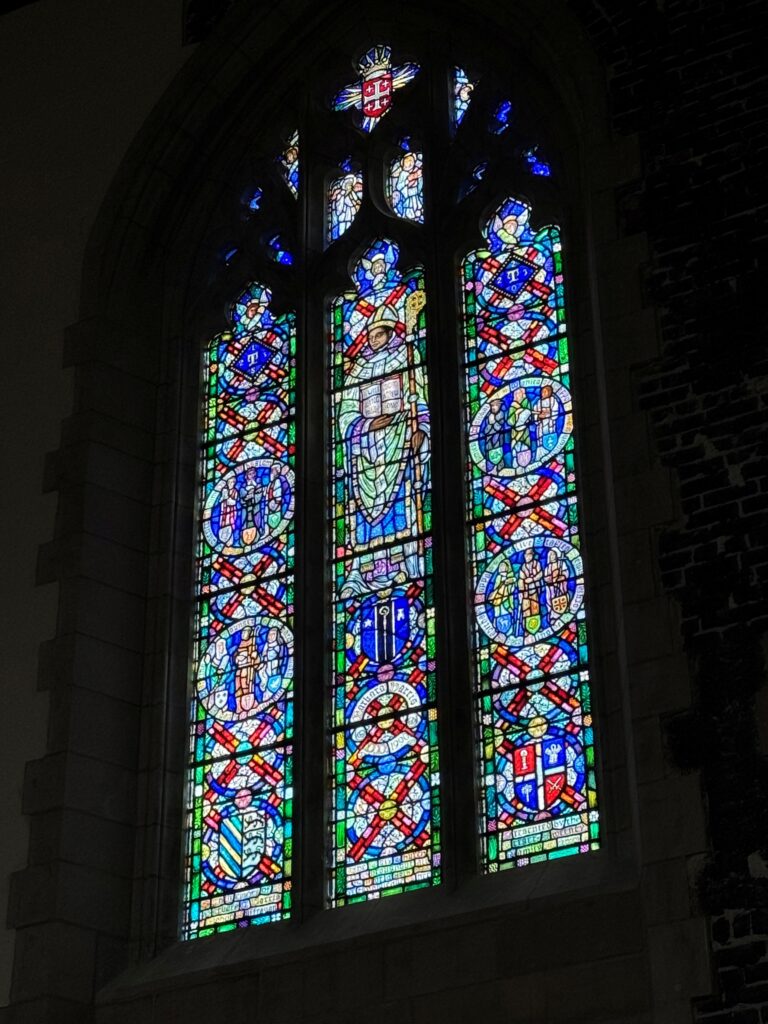
Berger-Sweeney and her family funded the design and creation of a large stained-glass window in the Trinity College Chapel. “It’s a wonderful legacy to the College to leave something so permanent,” Berger-Sweeney said. The window’s official dedication will take place in the Chapel on November 2, 2025, at 4:00 p.m.
During the first moments of her first visit to campus with her family about 12 years ago, Berger-Sweeney stepped through the Downes Clock Tower archway and heard someone playing the organ in the Chapel. “It was a hymn that I knew, and I thought that must be a sign,” she said. “That was my very first impression of Trinity College, and that’s where we wanted to leave our gift to Trinity.”
Installed in June of this year, the window is located on the southern side of the high altar in the Chapel’s chancel. Its theme is “the Holy Church throughout all the world” and it depicts figures who represent the history and diversity of the Episcopal Church and the wider Christian tradition.
Christopher Row ’91—the curator of the Trinity College Chapel, who designed the window with glazier Greg Gorman—said that the inspiration for the iconography came from one of Berger-Sweeney’s letters to the community during Trinity’s Bicentennial, which was celebrated in 2023. “She said that Trinity should build on the best of its traditions and celebrate its history while being very much a college of the 21st century; it’s a great balance,” Row said. “We chose figures that represent the church and its 2,000 years of history, while also being intentionally inclusive.”
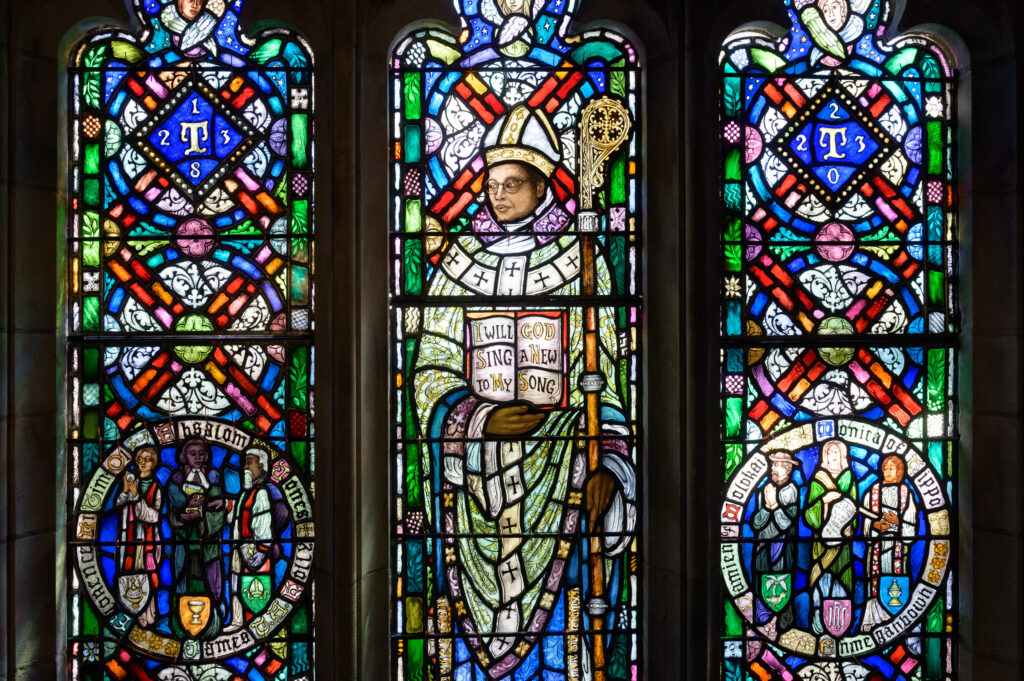
The central figure depicted in the window is Barbara Harris (1930-2020), the first woman consecrated a bishop in the Anglican Communion. Harris received an honorary Doctor of Divinity degree from Trinity in 1990.
Berger-Sweeney had met Harris several times, as Harris was suffragan bishop of the Episcopal Diocese of Massachusetts when Berger-Sweeney and her family were practicing in that church. “It wasn’t until I came to Trinity that I learned that she had been given an honorary degree,” Berger-Sweeney said. “When I heard of the symbolism and the diversity that was represented in this window, I thought, ‘This just feels right to me.’ My family made the commitment [to fund the window] in the Bicentennial year, so the dates 1823 and 2023 appear at the top. It felt like just the right gift for our family to leave behind.”
Row said that prior to the image of Harris, there was only one Black American depicted in the Chapel’s art: an emancipated slave boy next to President Abraham Lincoln in the window above the high altar that was gifted by former Trinity President Remsen Brinckerhoff Ogilby. “To honor Barbara Harris and to show the 12 months of the church calendar with temporal diversity, geographic diversity, racial and ethnic diversity, and gender diversity seemed like a very appropriate 21st-century approach,” Row said. [See the full list of historical figures depicted in the Chapel window in the sidebar below, or click here.]
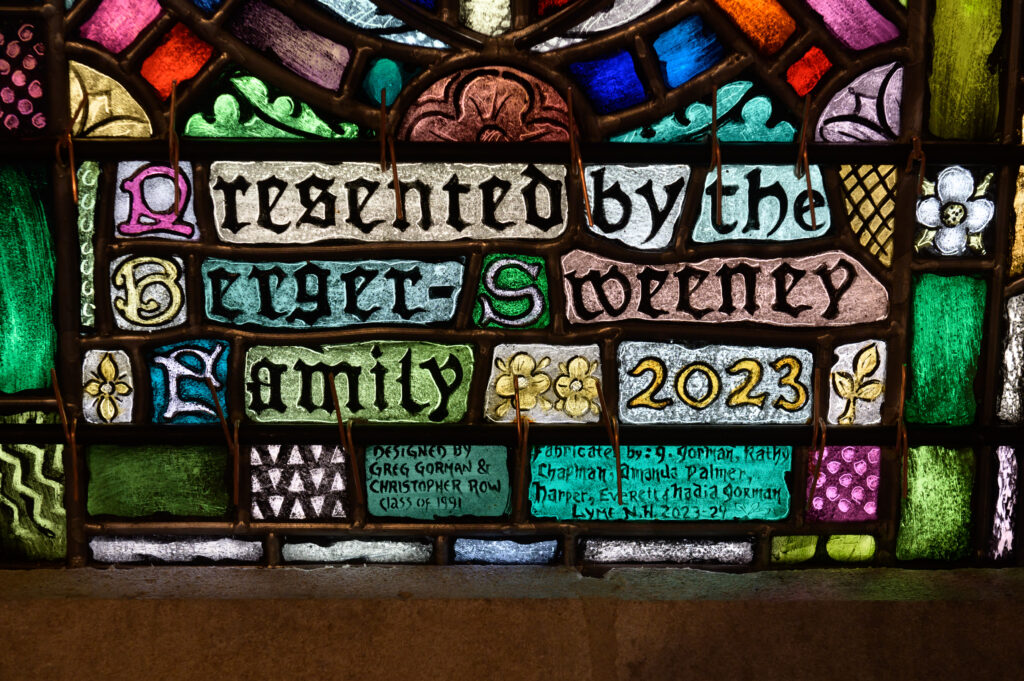 Row added that the new window continues the process of installing permanent stained-glass in the Chapel, the decoration of which was cut short by the financial realities of the Great Depression.
Row added that the new window continues the process of installing permanent stained-glass in the Chapel, the decoration of which was cut short by the financial realities of the Great Depression.
“The bright, diamond-patterned glass which fills most of the windows in the Chapel is actually ‘temporary’ glass,” Row said. “This new window marks the first major stained-glass to be installed in the Chapel since the 1940s. This is the style of glass intended by the architect, Philip Hubert Frohman, who also designed the Washington National Cathedral.”
The entire process from design to installation took about two years. “Seeing it installed was particularly exciting, when you realize that glass like that will go all the way down the Chapel. For me as the curator, it’s about following the architect’s intentions. It will be a breathtaking space,” Row said. “Trinity is very thankful to President Berger-Sweeney for her extraordinary generosity.”
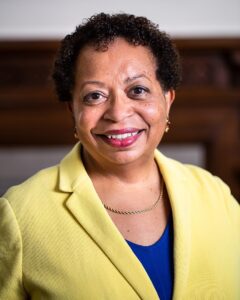
The Very Rev. Dr. Marcus George Halley, College chaplain and dean of spiritual and religious life, said that the new window represents the progress of the College. “It shows the community as both holding onto its traditions and values—the things that make it Trinity—but also finding ways to innovate and expand on that tradition, so that people who may not have been included initially are included now,” he said. “I think the window really speaks to the tradition and the innovation that President Berger-Sweeney championed in her tenure.”
During his inauguration as Trinity’s 23rd president, Daniel G. Lugo thanked Berger-Sweeney for all she has done for Trinity. “Under her leadership, the College expanded financial aid, launched the bold Trinity Plus curriculum, strengthened Trinity’s commitment to equity and inclusion, and deepened our bonds with Hartford,” Lugo said. “Joanne’s presidency was not mere stewardship—it was transformation. She leaves a stronger endowment, a more diverse community, and a revitalized sense of purpose.”
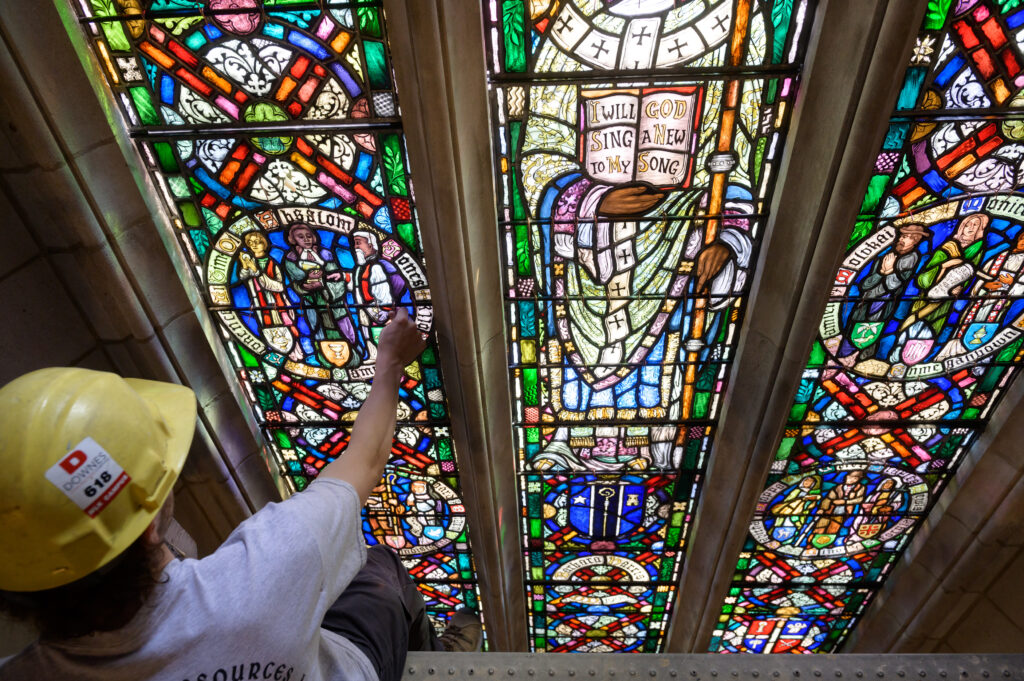
Berger-Sweeney said that she hopes the window will serve as a reminder of Trinity’s history and its mission to constantly grow and improve. “The Bicentennial was a time to reflect on a full and thorough history of the College—the good parts and not so good parts, and not just from one perspective,” she said. “We thought broadly about the past and how it laid a foundation for the Trinity of today, and about how to guide the Trinity of the future. I felt the same way when thinking about this window.
“I hope that the Trinity community appreciates the richness of the history of the College. That includes its religious past, because even though it’s not a religious school, it was founded by an Episcopal bishop,” Berger-Sweeney added. “I want people to remember the importance of the past, the present, and the diverse, inclusive future when looking at the College. The Chapel window is just a little sign of the inclusion that will now forever be a part of Trinity’s history, whether I’m here or not.”
Learn more about the Chapel window gifted by the Berger-Sweeney family
By Christopher Row ’91
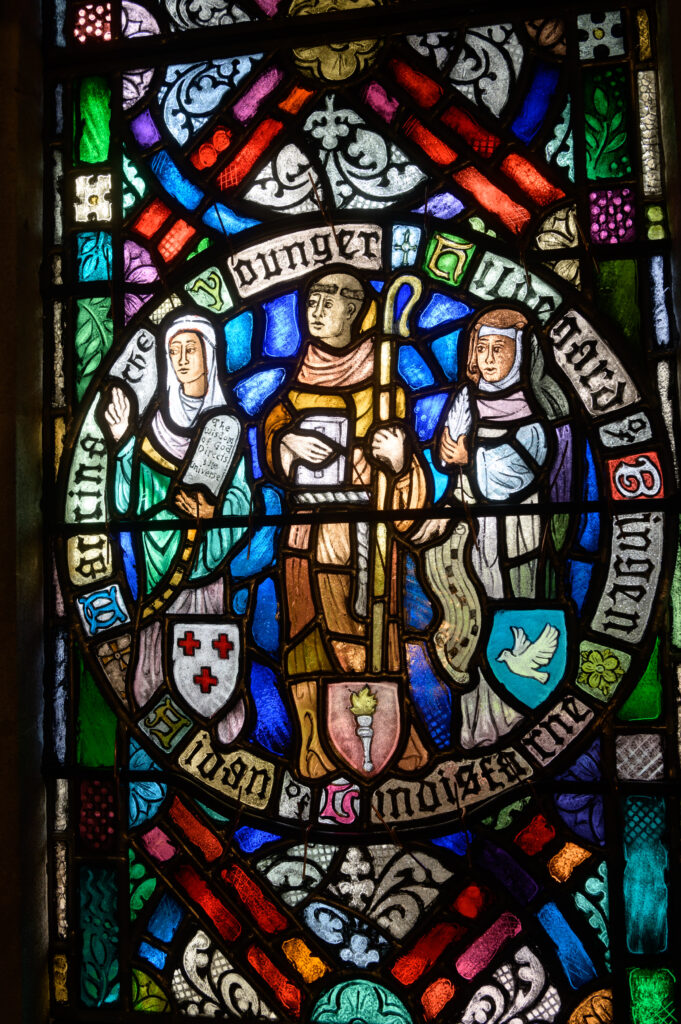 The window depicts the fourth stanza of the “Te Deum,” a Latin hymn of praise to God, with the “Te Deum” being the theme of the window over the high altar. That fourth stanza is, “The Holy Church throughout all the world doth acknowledge thee.”
The window depicts the fourth stanza of the “Te Deum,” a Latin hymn of praise to God, with the “Te Deum” being the theme of the window over the high altar. That fourth stanza is, “The Holy Church throughout all the world doth acknowledge thee.”
Most of the figures in the window “look” up and to the left—directly toward the figure of Christ in the window over the high altar—as do the figures in that main window over the high altar.
The iconography of the window depicts the Church throughout the world—and throughout space and time. We wanted that iconography to honor President Berger-Sweeney’s vision of Trinity College—especially in the College’s Bicentennial year—as an institution which builds and preserves that which is best from our history and traditions, while also being very much a College of the 21st century. To that end, we sought to design a window which was strictly Gothic Revival—a window which conformed both to good Gothic Revival principles of glass design, while also manifesting the specific vision and intentions of the architect and donor of the Chapel. We also wanted to present an iconography that very much honored our own moment in time. The figures depicted in the window, therefore, were selected to encompass the broadest range of time, geography, race and ethnicity, and gender, all while being figures who played an important role in the life of the Church, throughout all the world.
The main figure is of Bishop Barbara Harris, first woman consecrated a bishop in the world-wide Anglican Communion. She also was awarded an honorary Doctor of Divinity degree from Trinity College in 1990.
Additionally, all of the figures were drawn from the Lesser Feasts and Fasts (the Church Calendar) of the Episcopal Church, including Harris.
In the four roundels, all 12 months of the Church year are represented—the feast day of each selected individual falling within each of the 12 months. Those figures are:
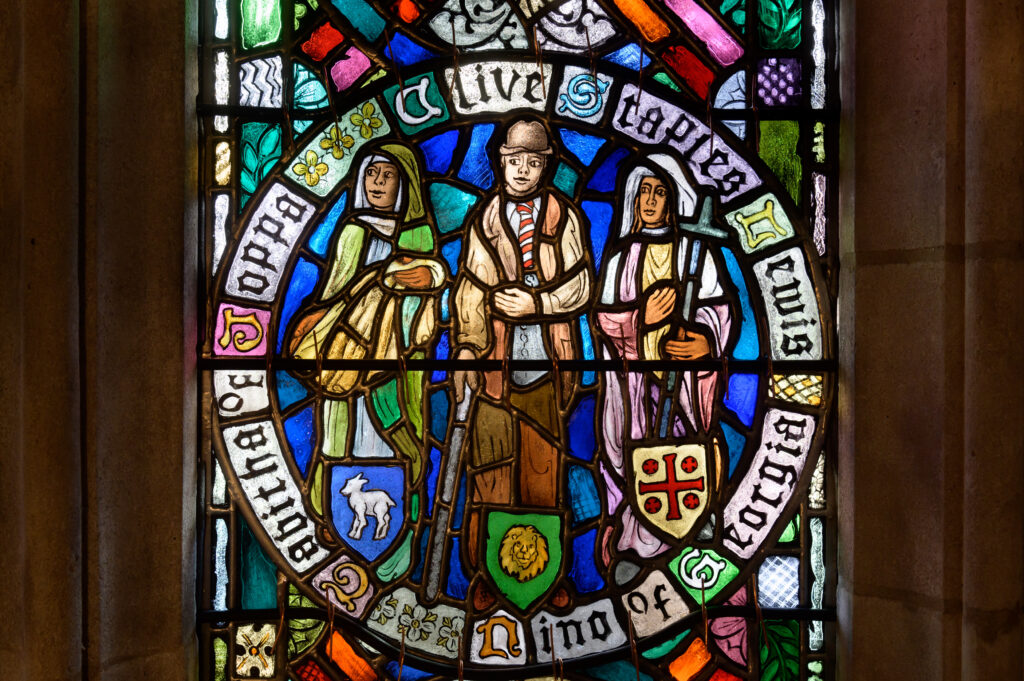 TOP LEFT ROUNDEL:
TOP LEFT ROUNDEL:
January: Florence Li Tim-Oi (first woman ordained a priest in the Anglican Communion—of which the Episcopal Church is a part)
February: Absalom Jones (first Black American ordained a priest in the Episcopal Church)
March: James T.A. Holly (first Black American consecrated a bishop in the Episcopal Church)
TOP RIGHT ROUNDEL:
April: Damien of Molokai (saint, priest, and pastor to the lepers of Molokai)
May: Monica of Hippo (saint and mother of Saint Augustine)
June: Enmegahbowh (first Amerindian ordained a priest in the Episcopal Church. It is worth noting that the first Amerindian consecrated a bishop in the Episcopal Church was Trinity College’s very own Bishop Steven Charleston, sometime chaplain of Trinity College.)
BOTTOM LEFT ROUNDEL:
July: Macrina the Younger (saint and teacher to her sainted brothers, two of the Cappadocian Fathers)
August: Aidan of Lindisfarne (saint, bishop, monk, and missionary to the Anglo-Saxons)
September: Hildegard of Bingen (abbess, mystic, polymath, and musician)
BOTTOM RIGHT ROUNDEL:
October: Tabitha of Joppa (saint and minister of “good works and acts of mercy”—from the “Acts of the Apostles”)
November: Clive Staples Lewis (British author better known as C.S. Lewis; professor, theologian, and foremost apologist for the Christian faith in the 20th century)
December: Nino of Georgia (saint, preacher, and evangelist of the early Church)
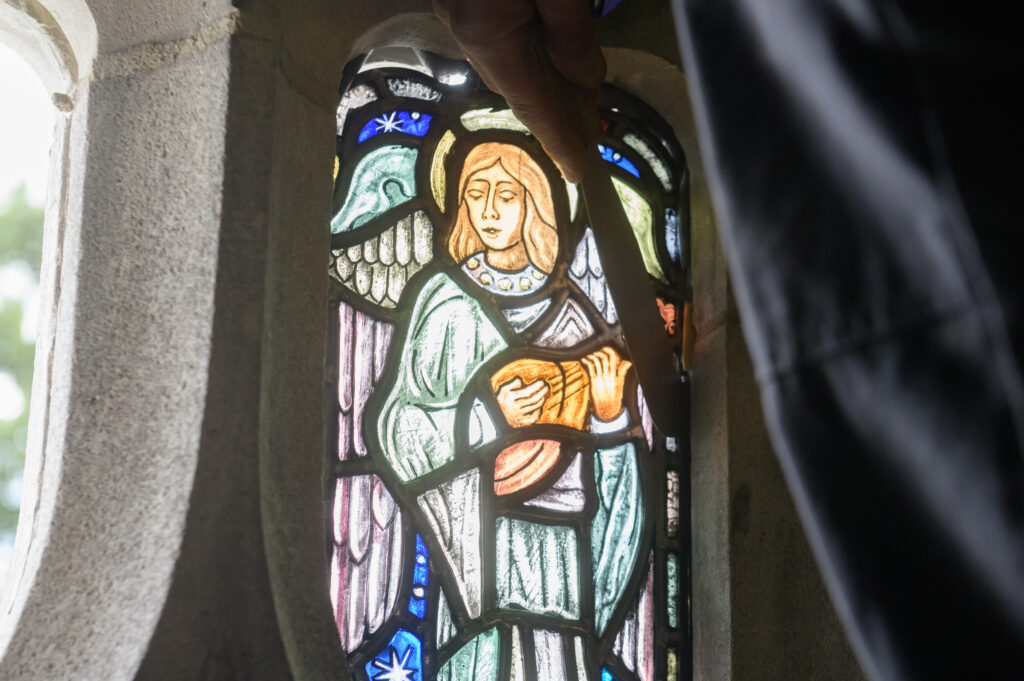 The two shields at the base of the outer two lancets are those of the Episcopal Dioceses of New Jersey (left) and South Carolina (right). The arms of all nine original dioceses of the Episcopal Church will be rendered, once the remaining three windows are fabricated. The arms of the ninth diocese, the Diocese of Connecticut, already has place of honor in the Great East Window by E.E. Sanborn, alongside the arms of the Diocese of London, which had ecclesiastical jurisdiction over Connecticut before the American Revolution.
The two shields at the base of the outer two lancets are those of the Episcopal Dioceses of New Jersey (left) and South Carolina (right). The arms of all nine original dioceses of the Episcopal Church will be rendered, once the remaining three windows are fabricated. The arms of the ninth diocese, the Diocese of Connecticut, already has place of honor in the Great East Window by E.E. Sanborn, alongside the arms of the Diocese of London, which had ecclesiastical jurisdiction over Connecticut before the American Revolution.
The shield beneath the feet of Bishop Harris is her devised personal arms as suffragan bishop of Massachusetts and is emblematic of her episcopal authority as a bishop of the Church.
The shield at the top of the window, in the quatrefoil, is the Jerusalem Cross, symbolic both of the Five Wounds of Christ, as well as of the Church throughout all the world. It is surmounted by a celestial crown, as the shield is an emblem of Christ.
As this window needed to reflect and embody the spirit of late 14th- and 15th-century style English glass, a number of appropriate mediaeval sources were referenced, both in terms of form and disposition of color.
A variety of outstanding stained-glass artists provided inspiration for this window, both in its overall form, and in its specific elements—including, but not limited to: Charles J. Connick; Henry Wynd Young; Christopher Whall; Charles Eamer Kempe; and Walter Tower.
Window credits:
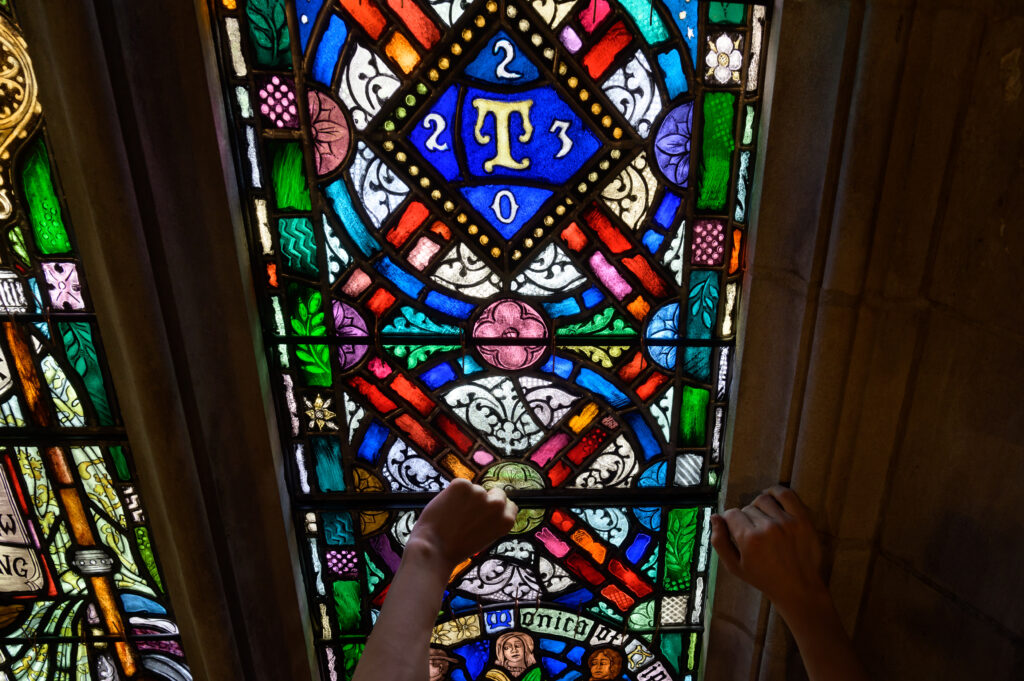 Greg Gorman—design of the window; watercolor sketch and cartooning; all aspects of fabrication, including glass selection, cutting, etching, easel black-lining, glass painting
Greg Gorman—design of the window; watercolor sketch and cartooning; all aspects of fabrication, including glass selection, cutting, etching, easel black-lining, glass painting
Christopher Row ’91—design of the window; research on figures and symbols; cartooning; coordination with Trinity College
Kathy Chapman—glass cutting, leading of the panels, easel black-lining
Amanda Palmer—cartooning, glass cutting, easel black-lining, cementing
Harper and Everett Gorman—general labor, cartooning
Nadia Gorman—studio and office manager
Stained Glass Resources—installation
Trinity College Chapel Stained-Glass Window from the Berger-Sweeney Family
Trinity College Chapel Stained-Glass Window from the Berger-Sweeney Family
Photos by Nick Caito.
Photo courtesy of Christopher Row ’91.
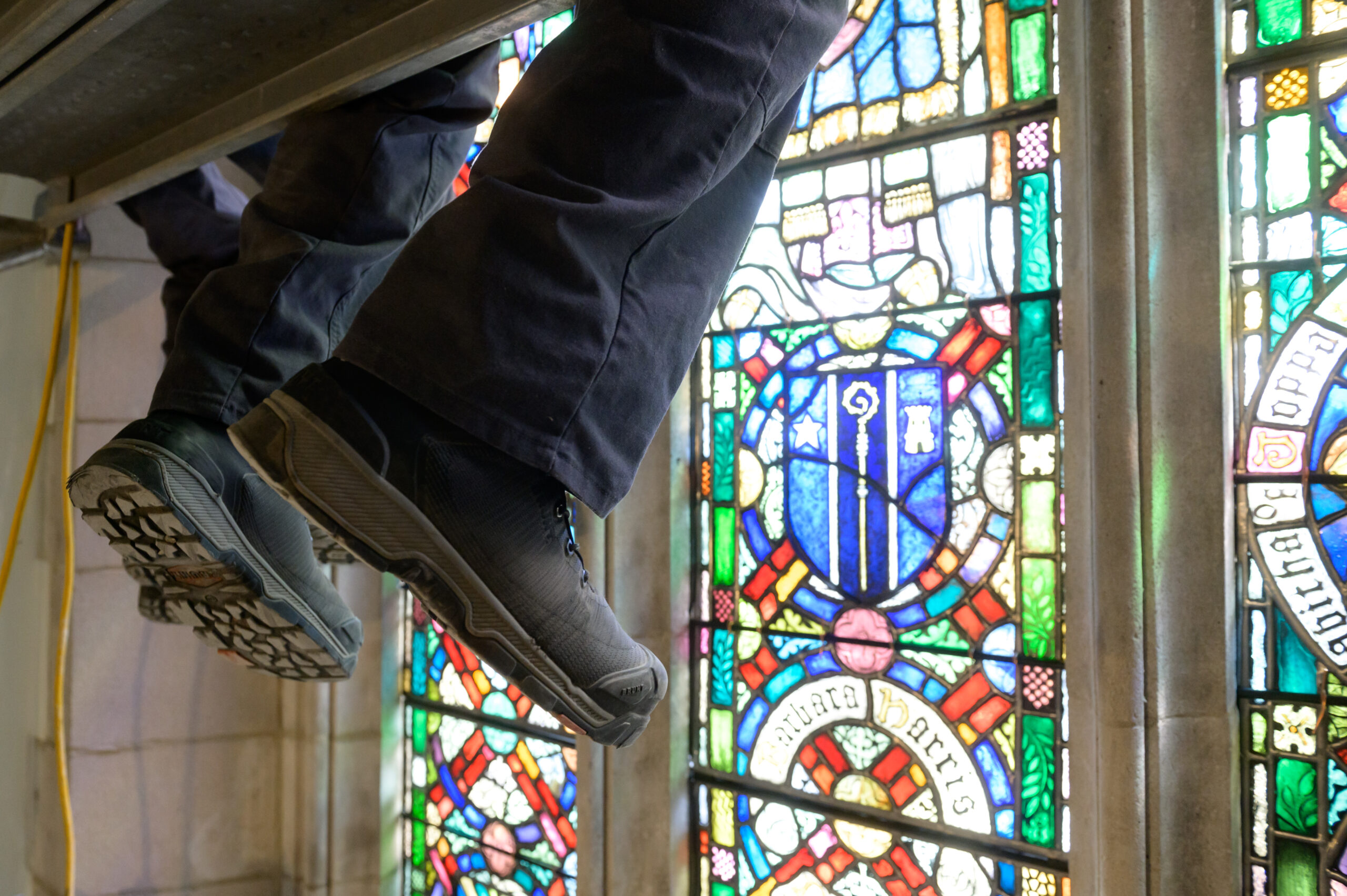
Photos by Nick Caito.
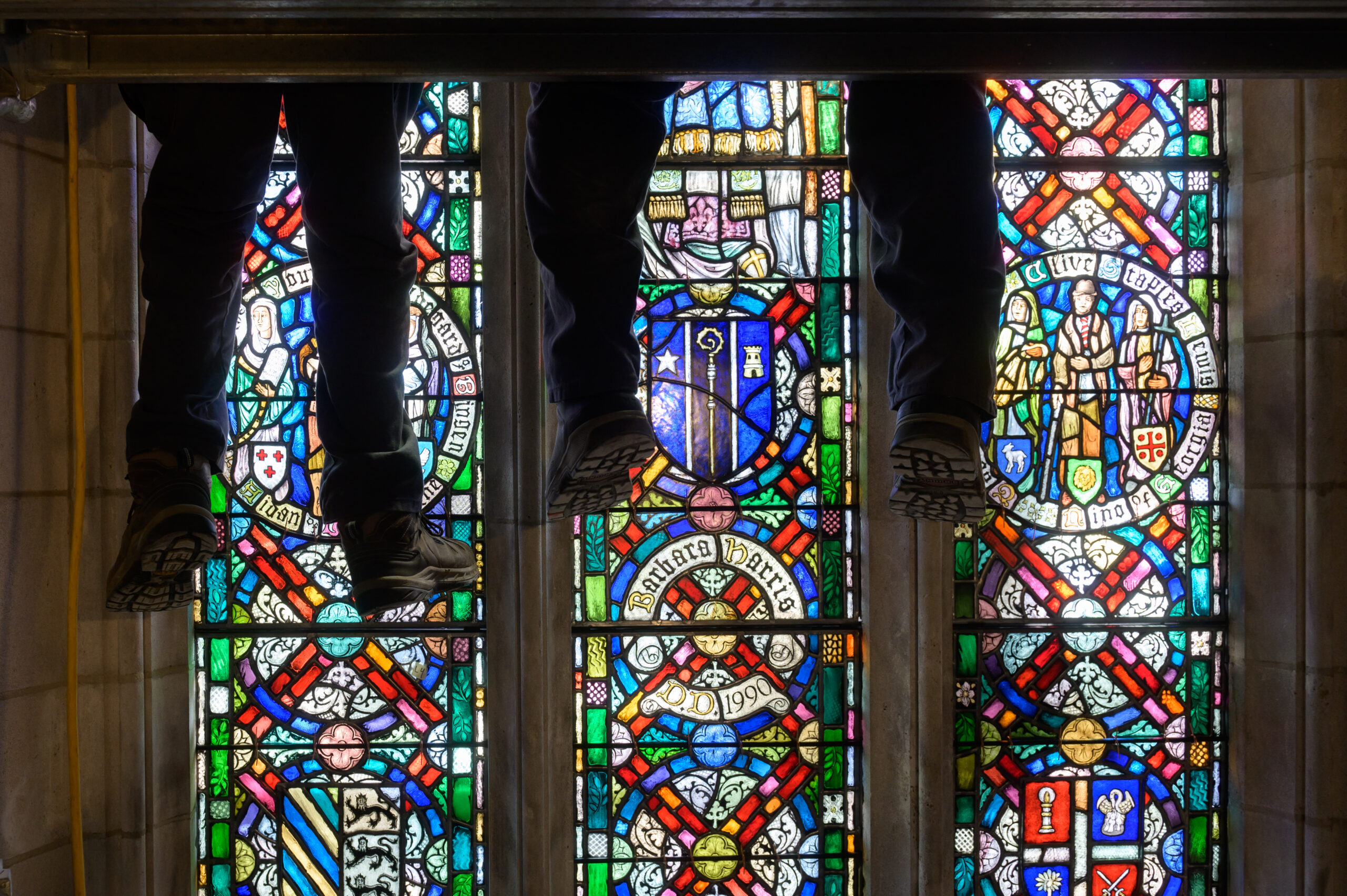
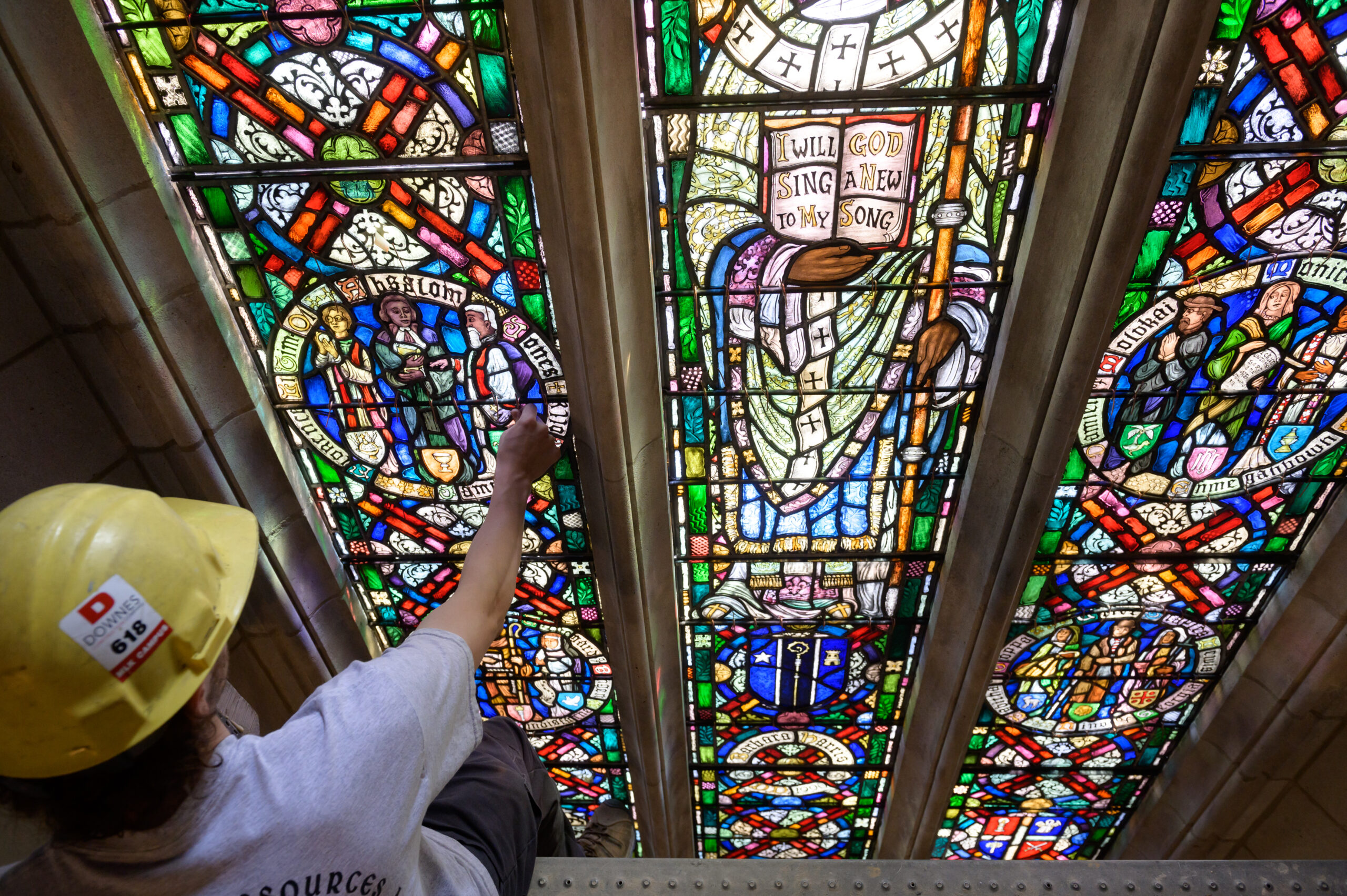
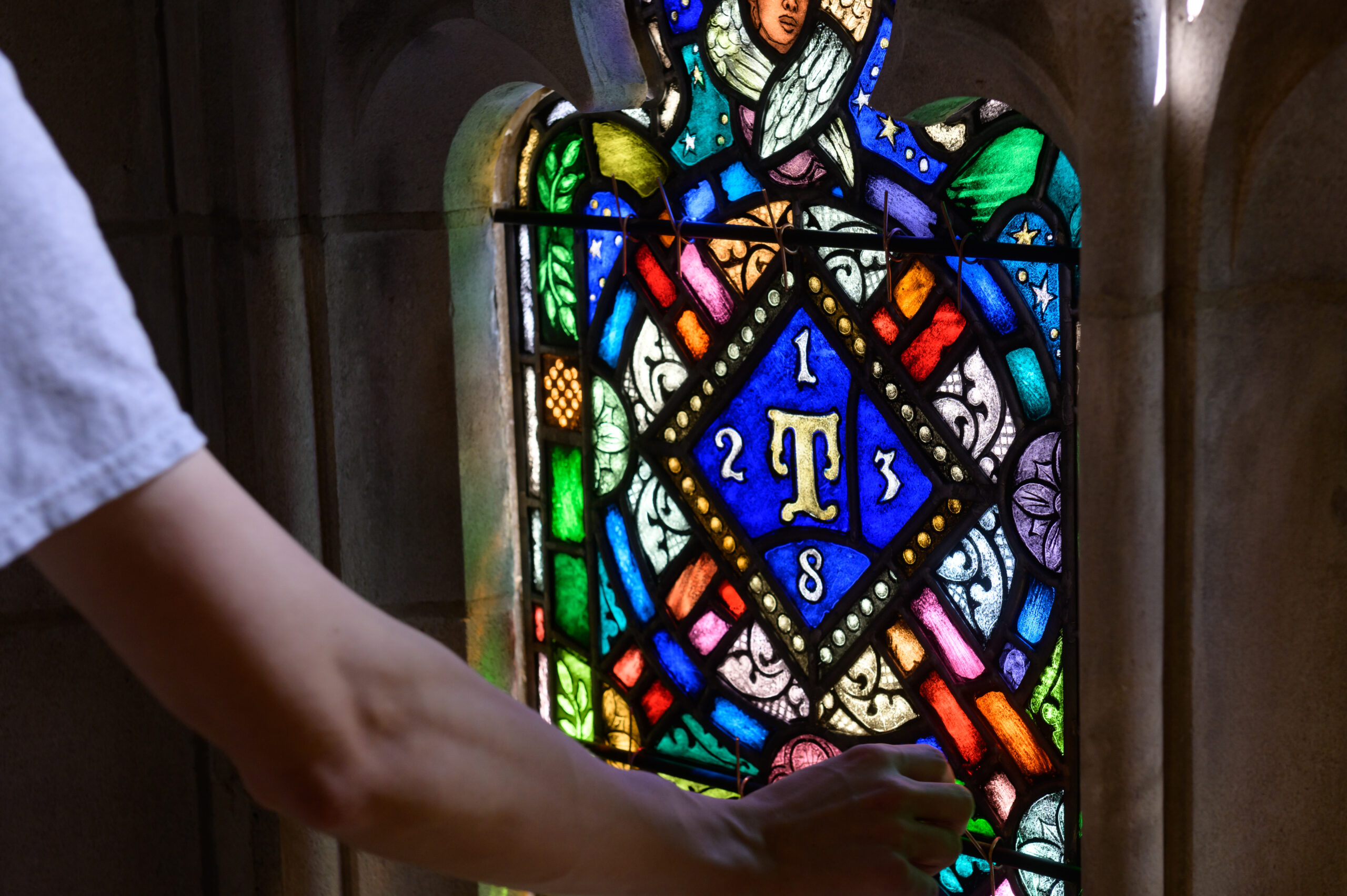
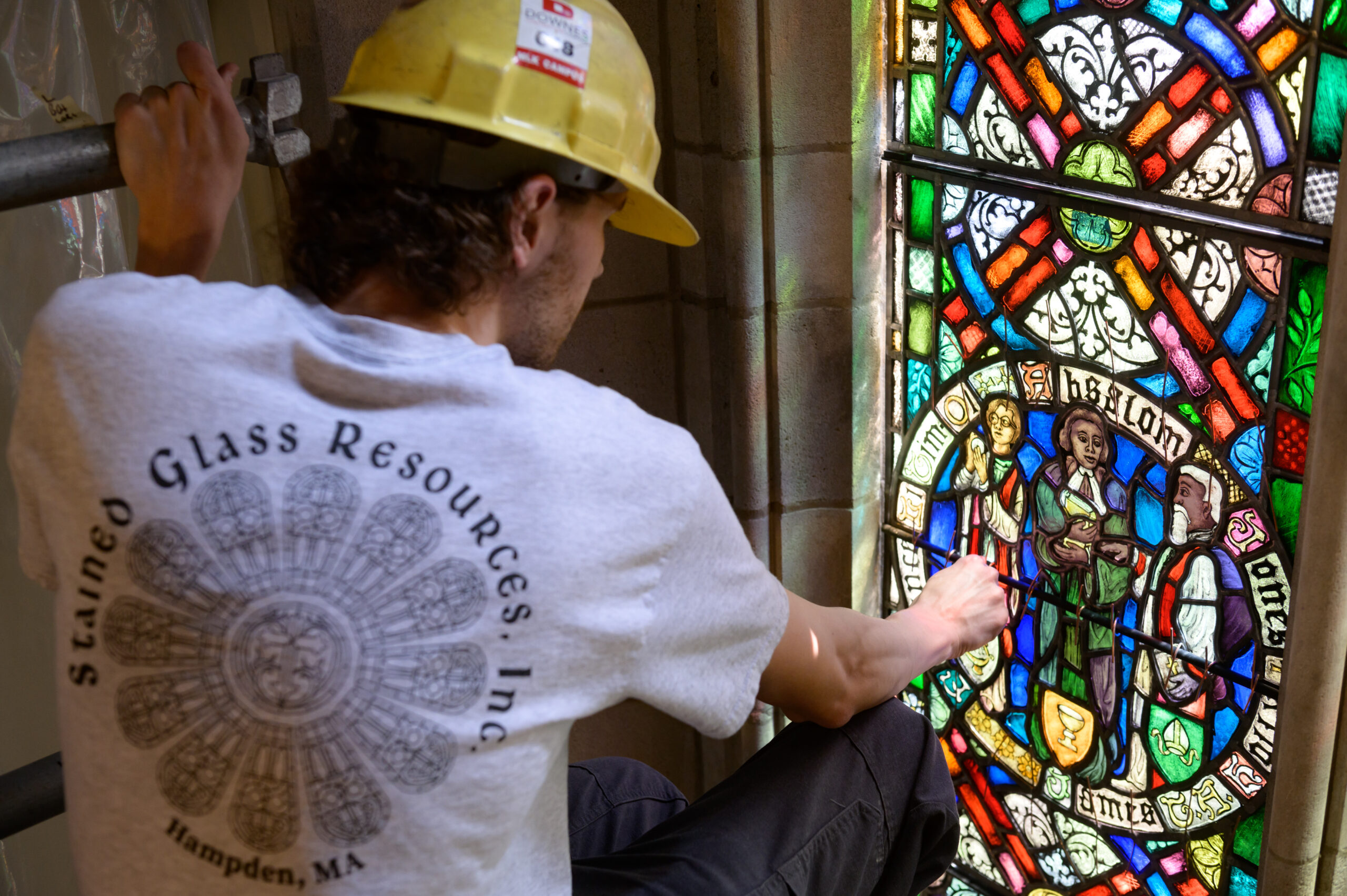
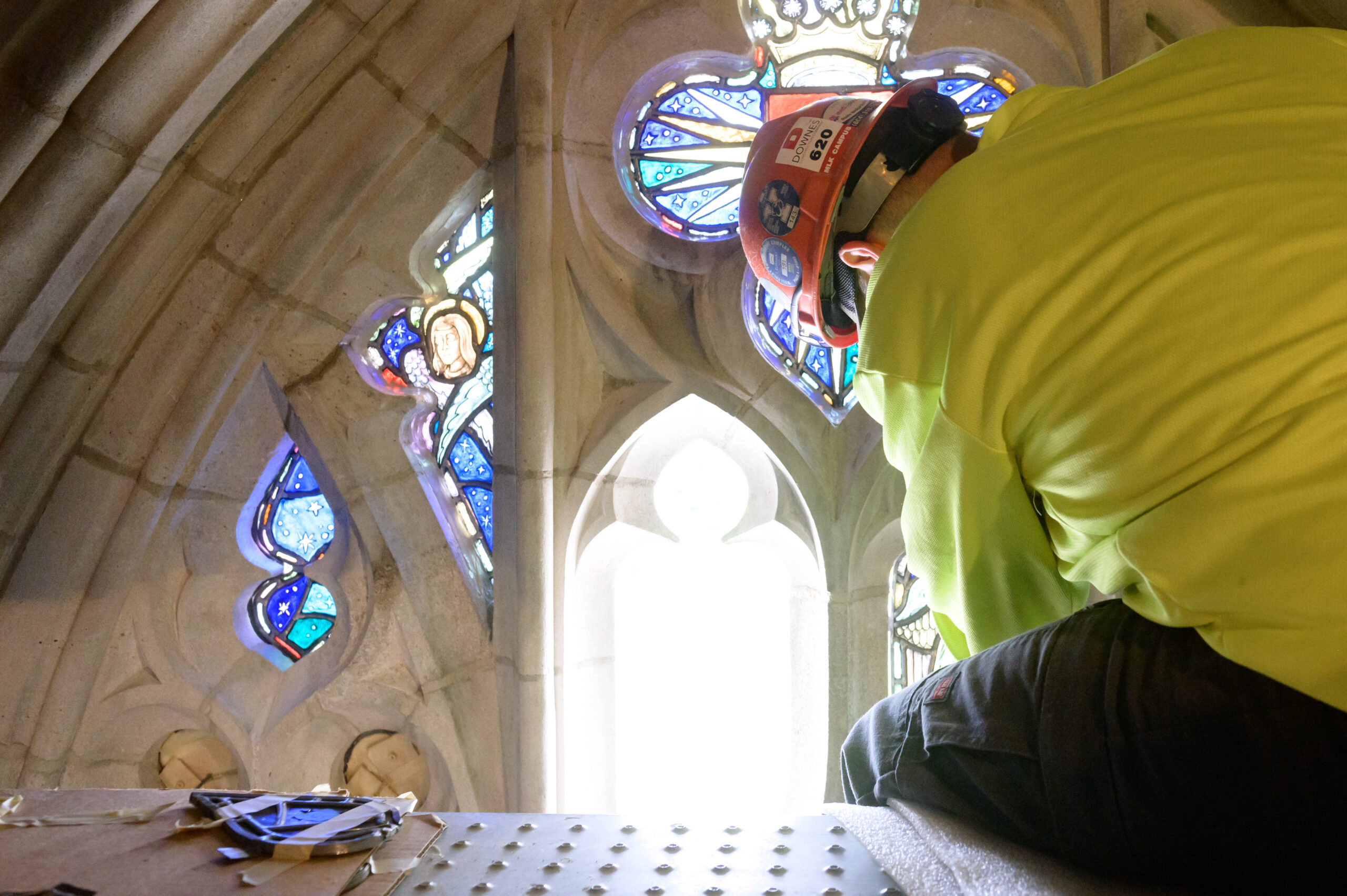
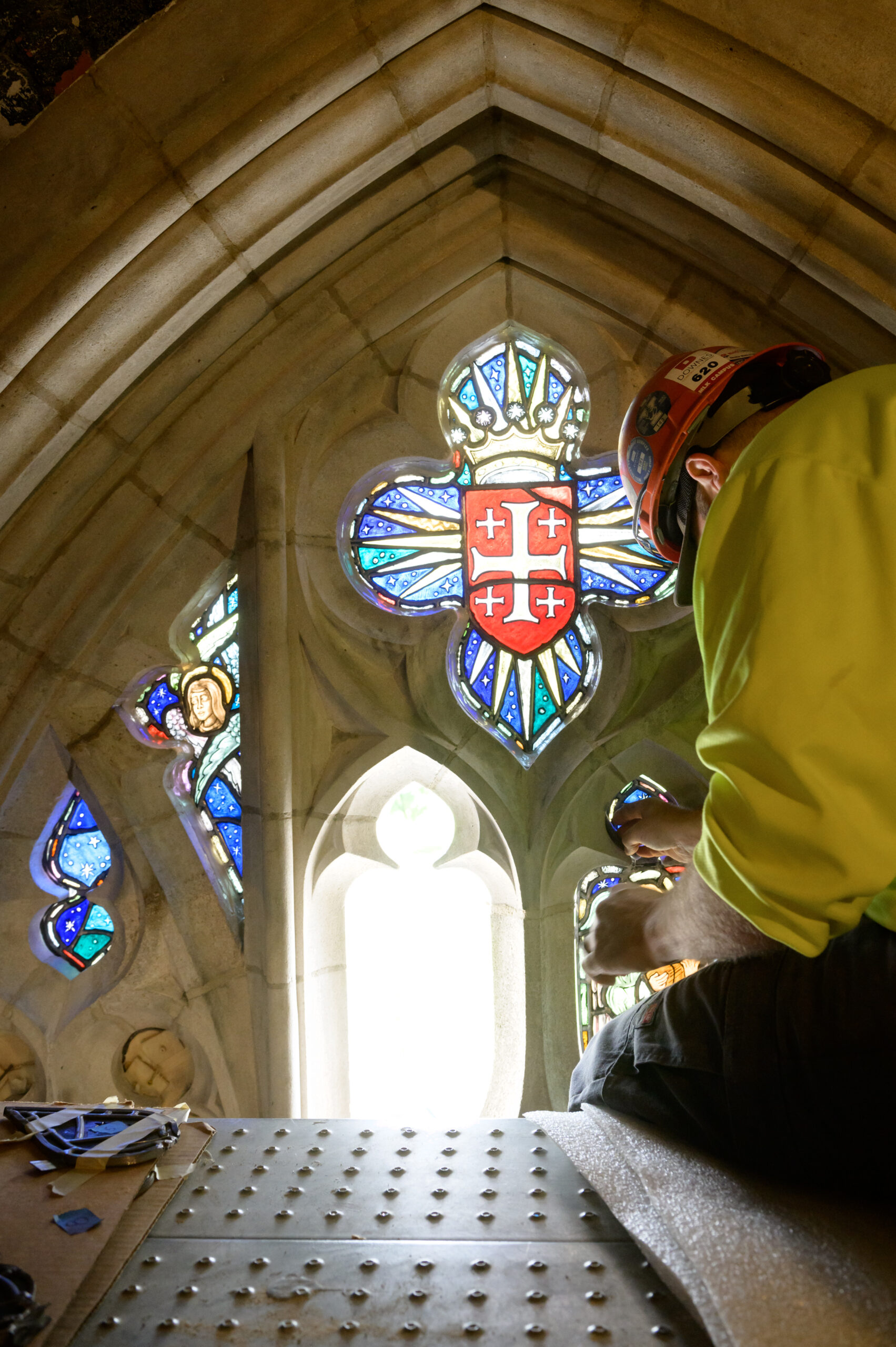
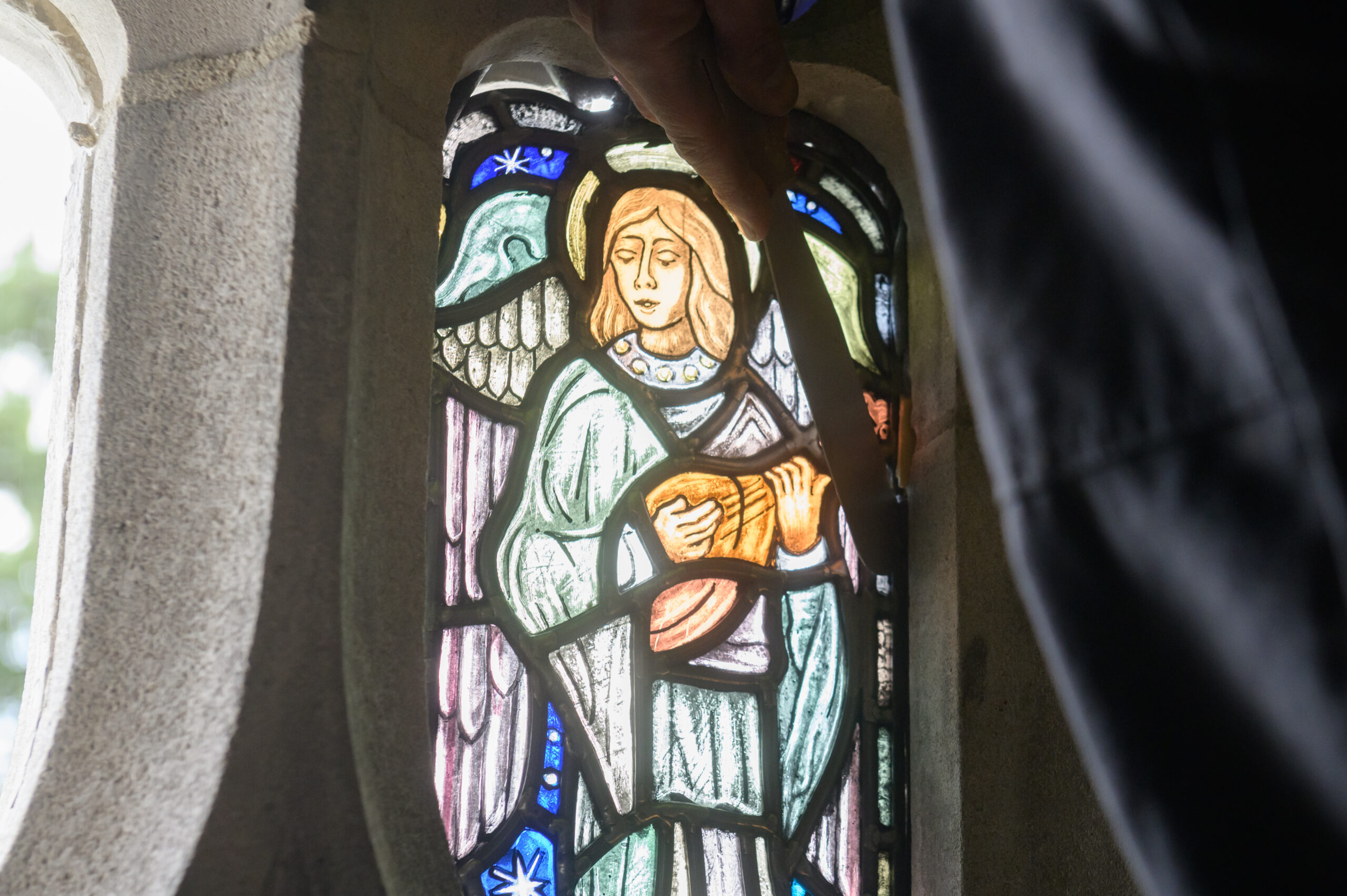
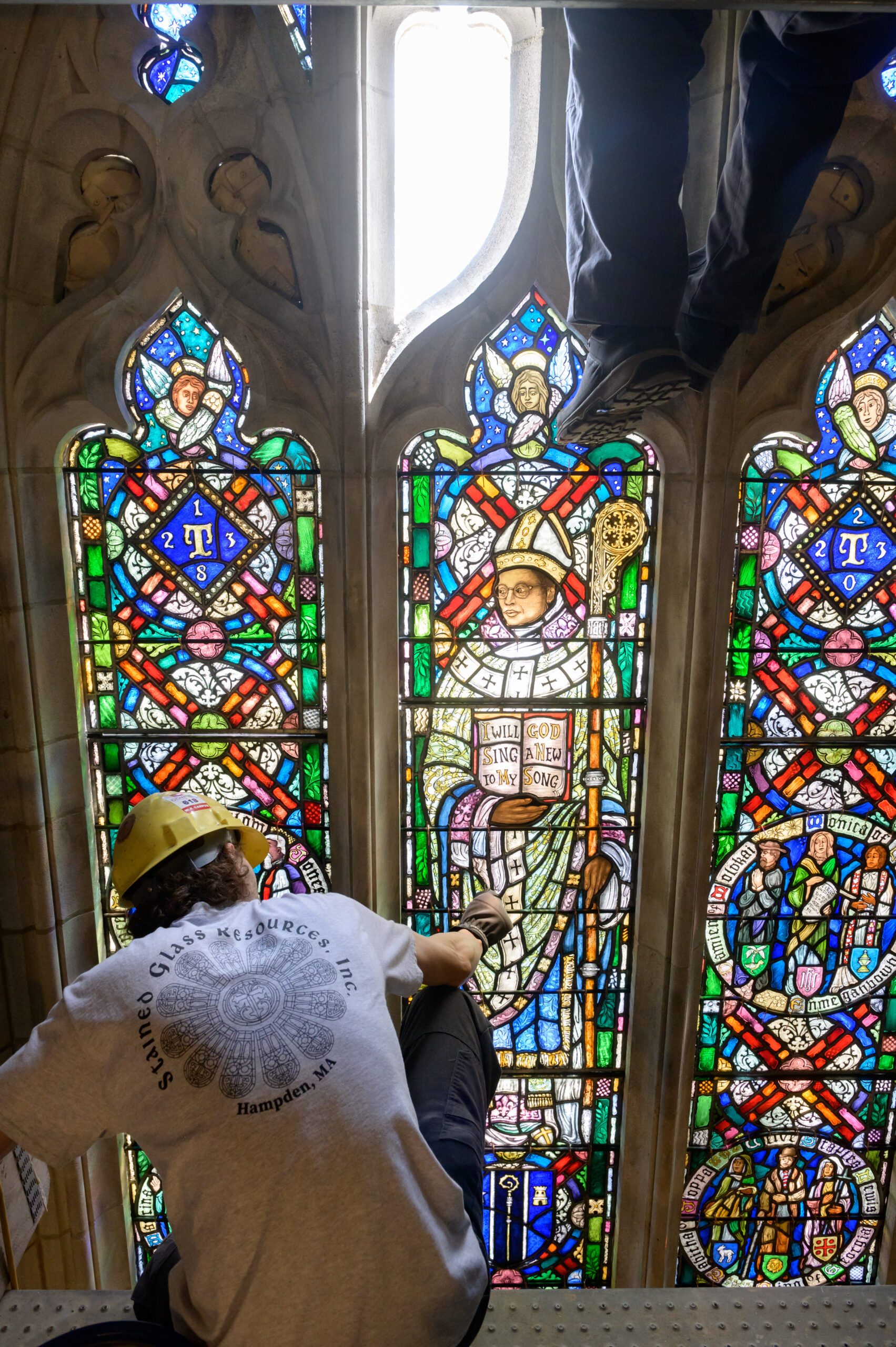
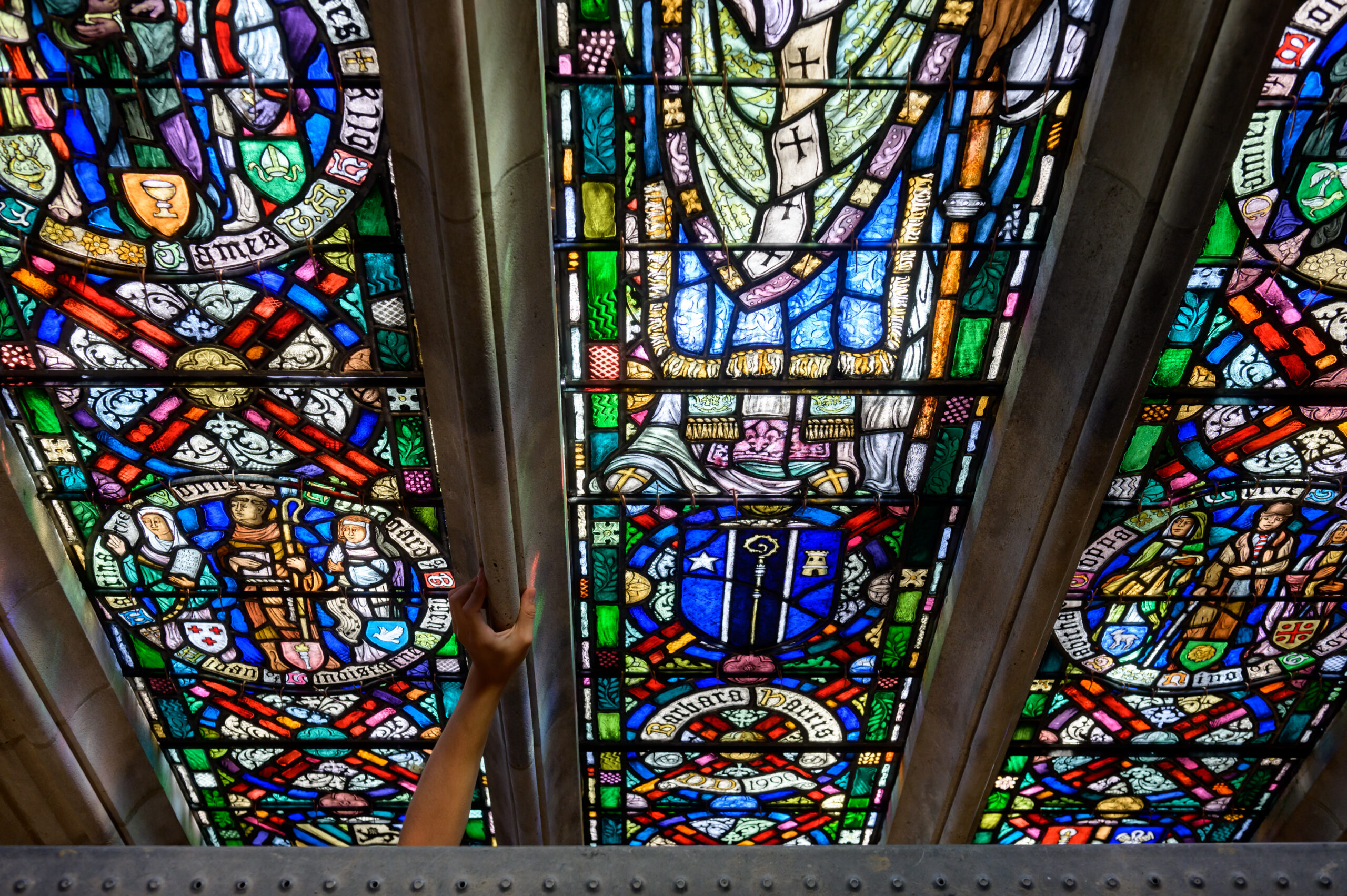
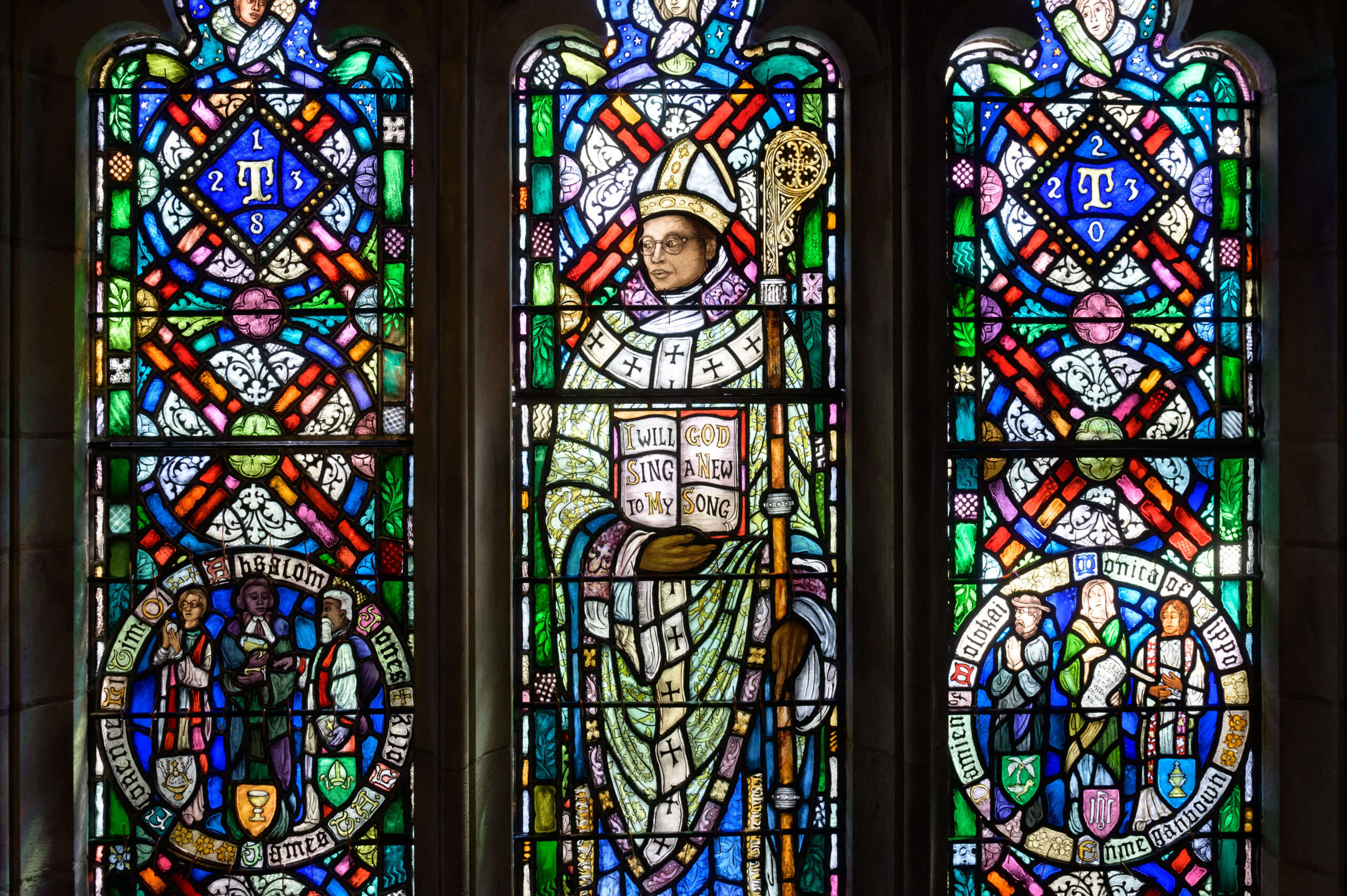
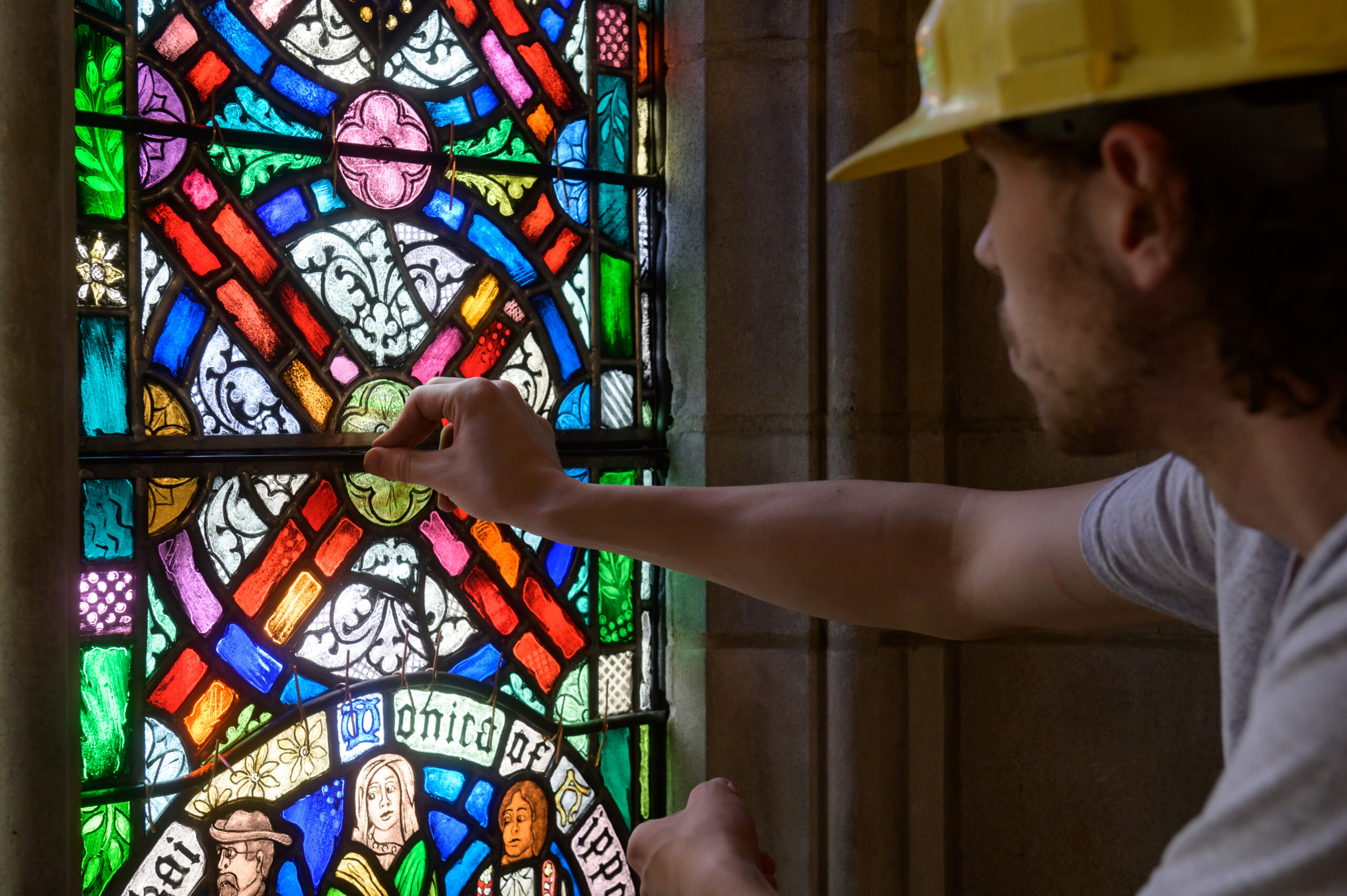
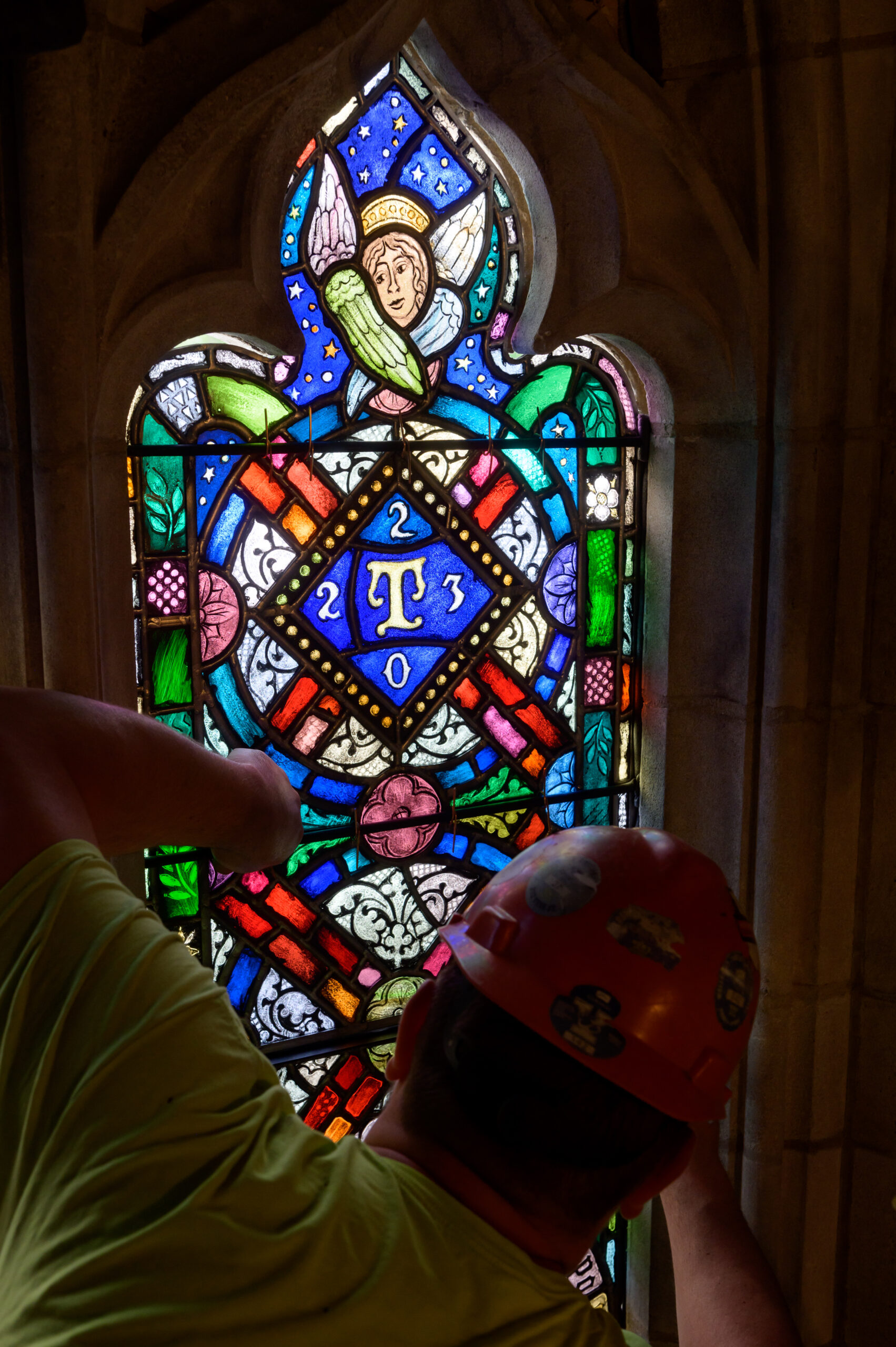
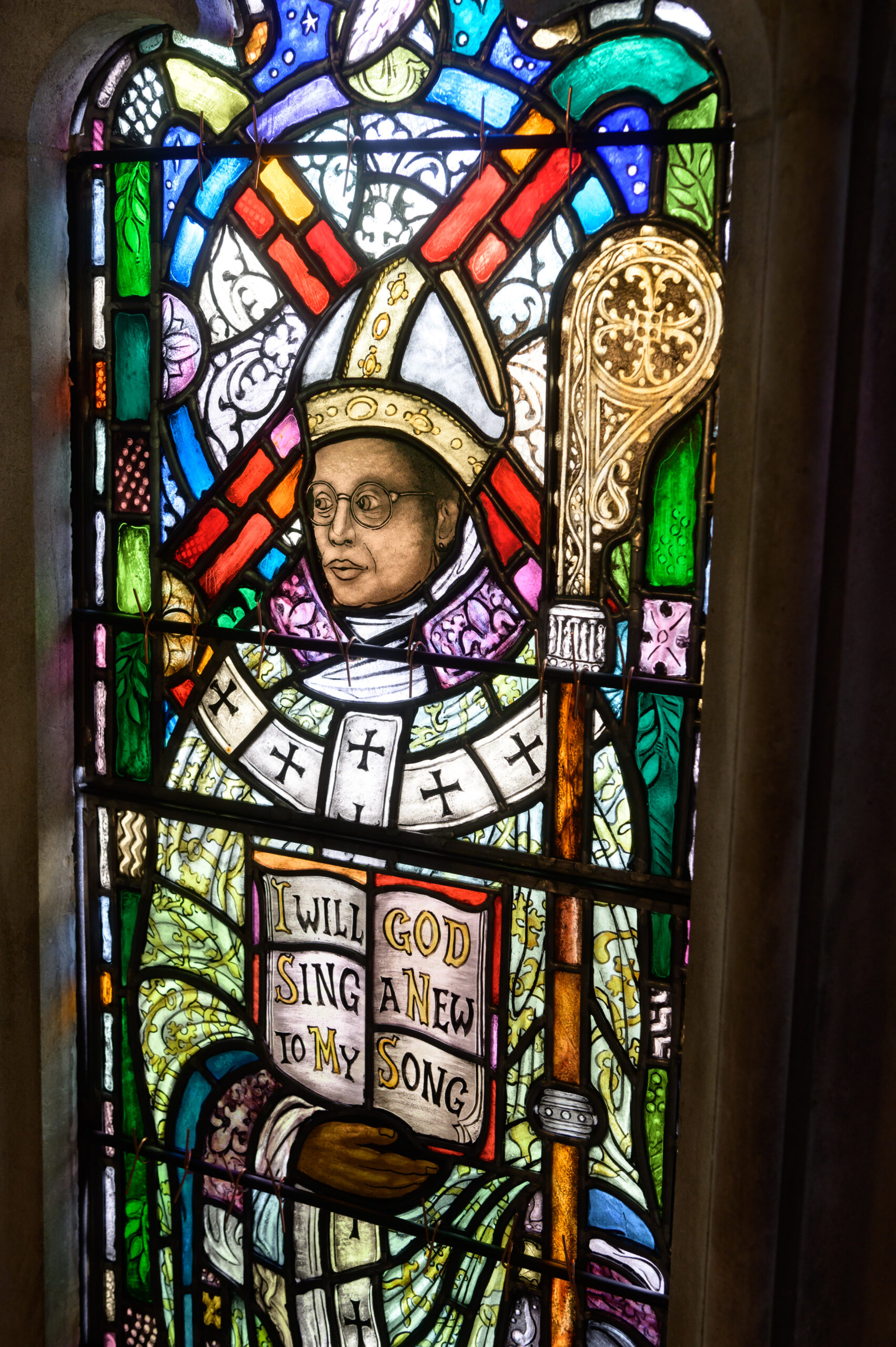
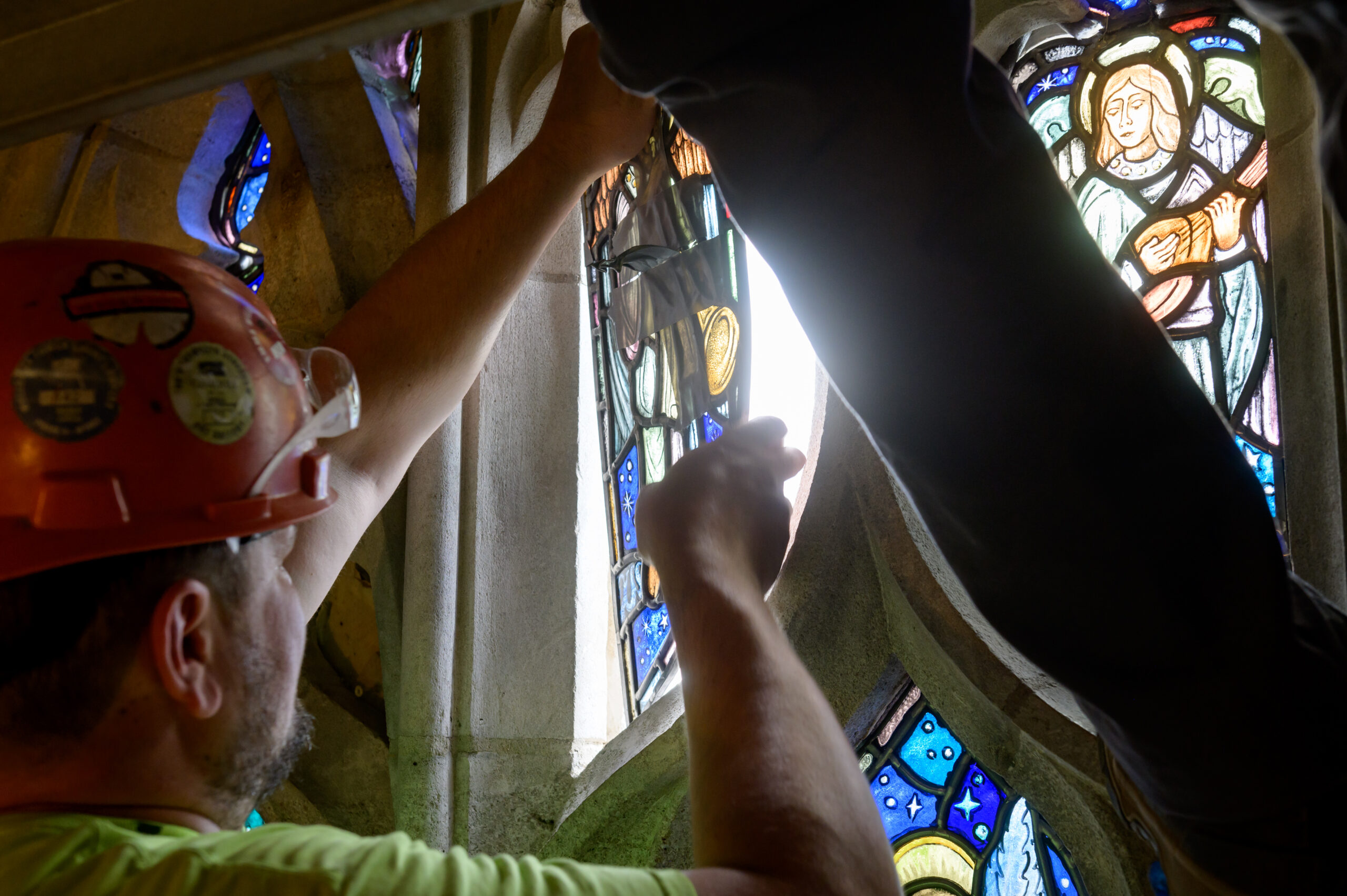
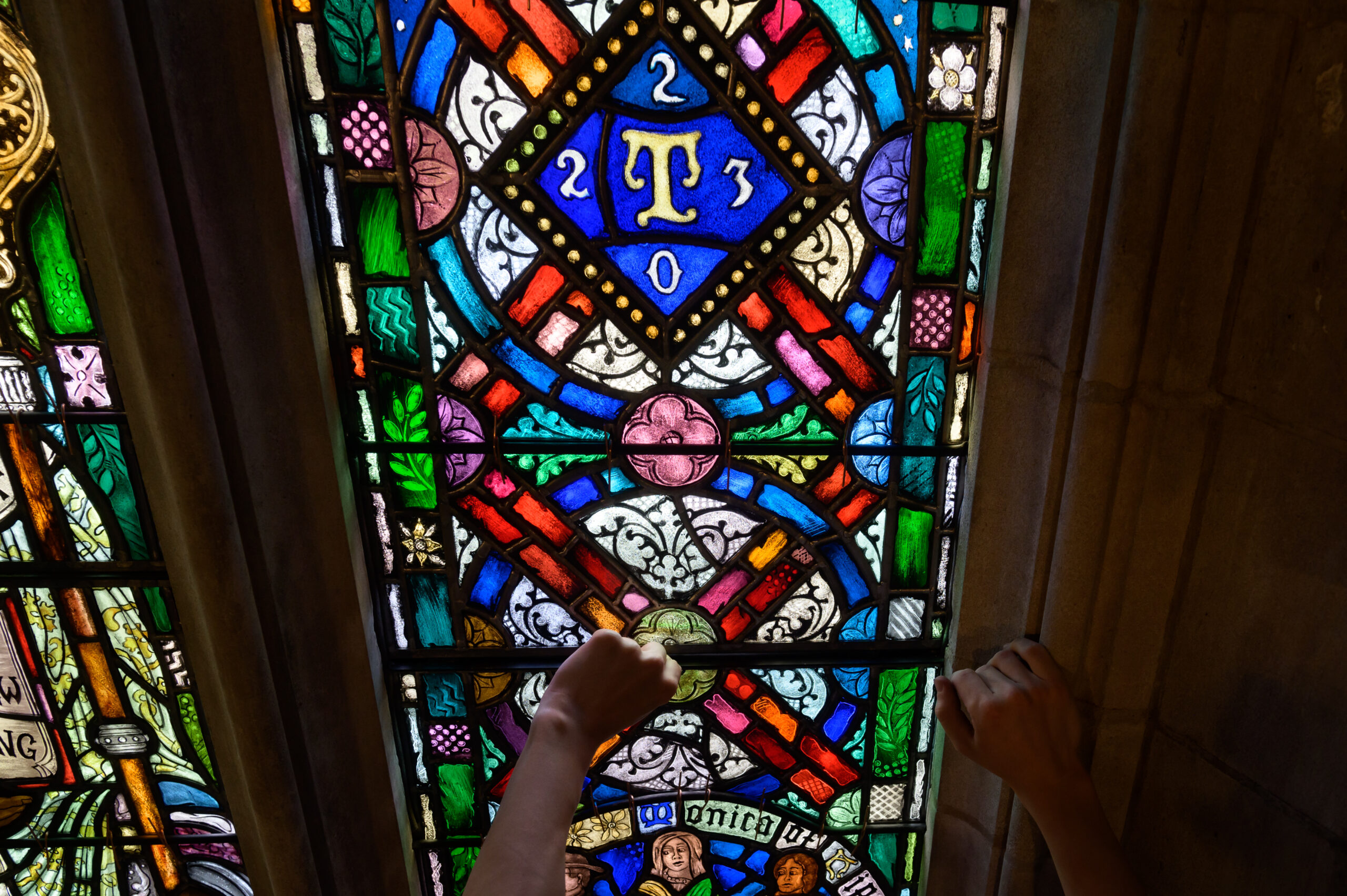
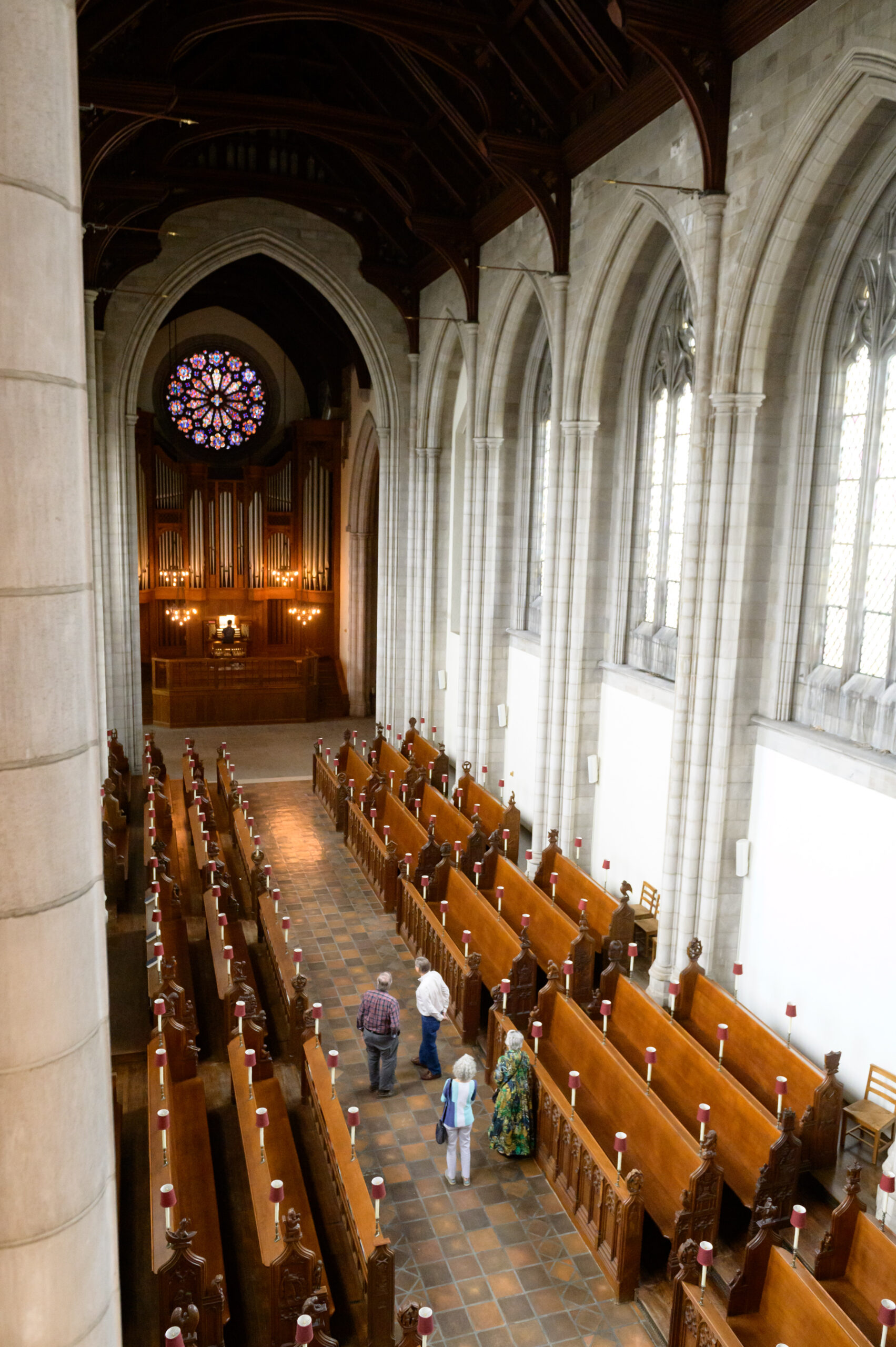
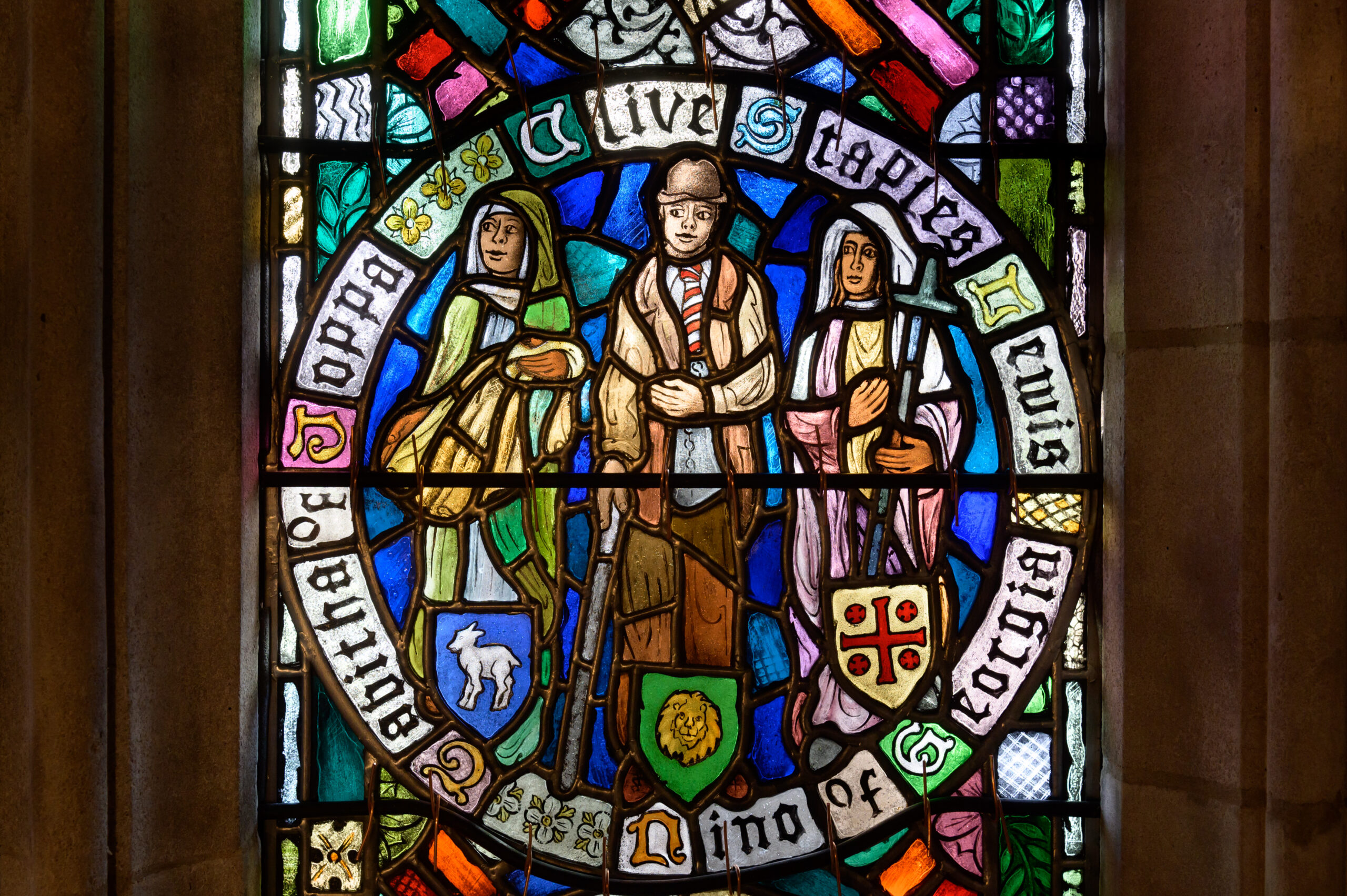
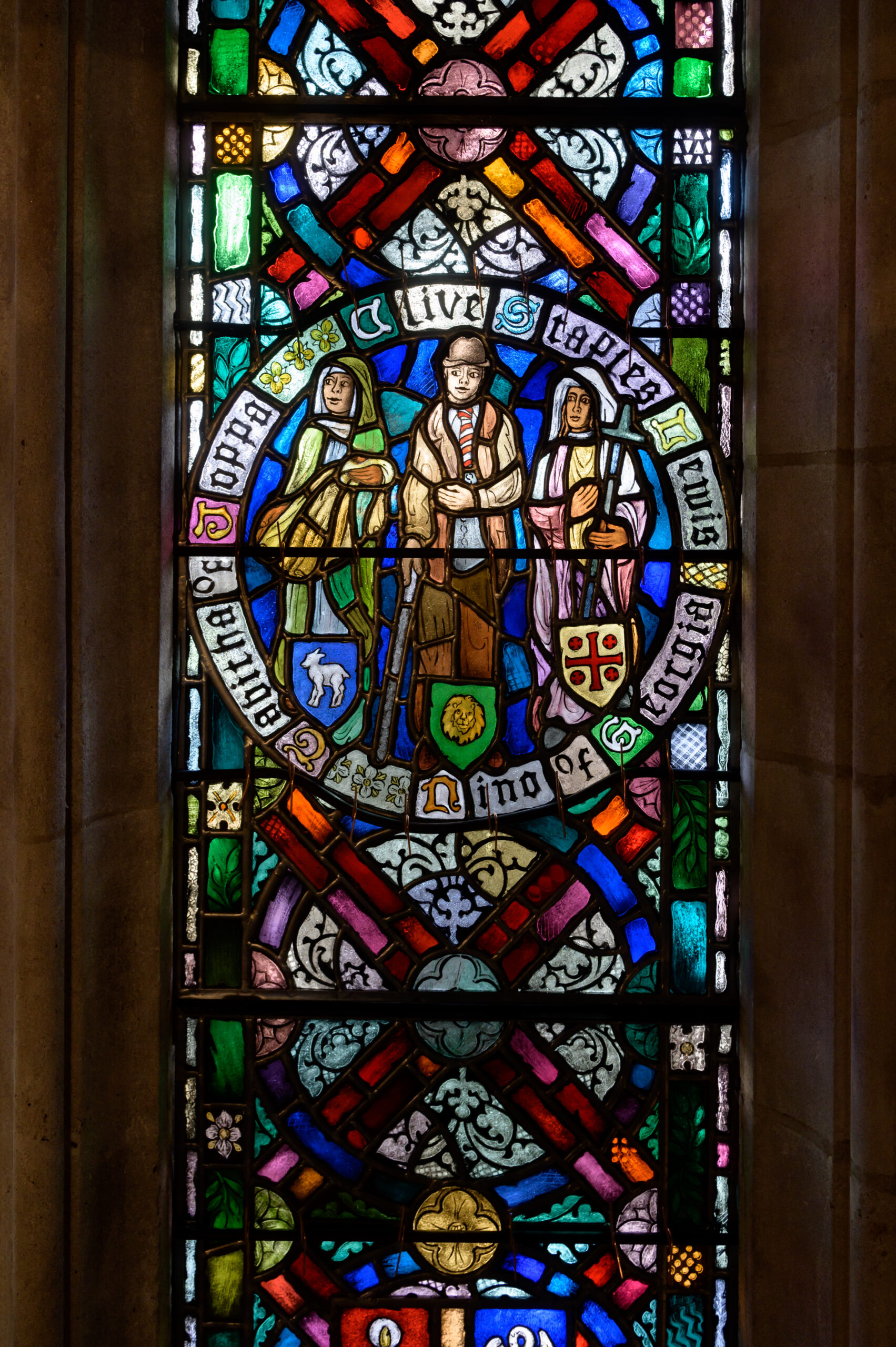
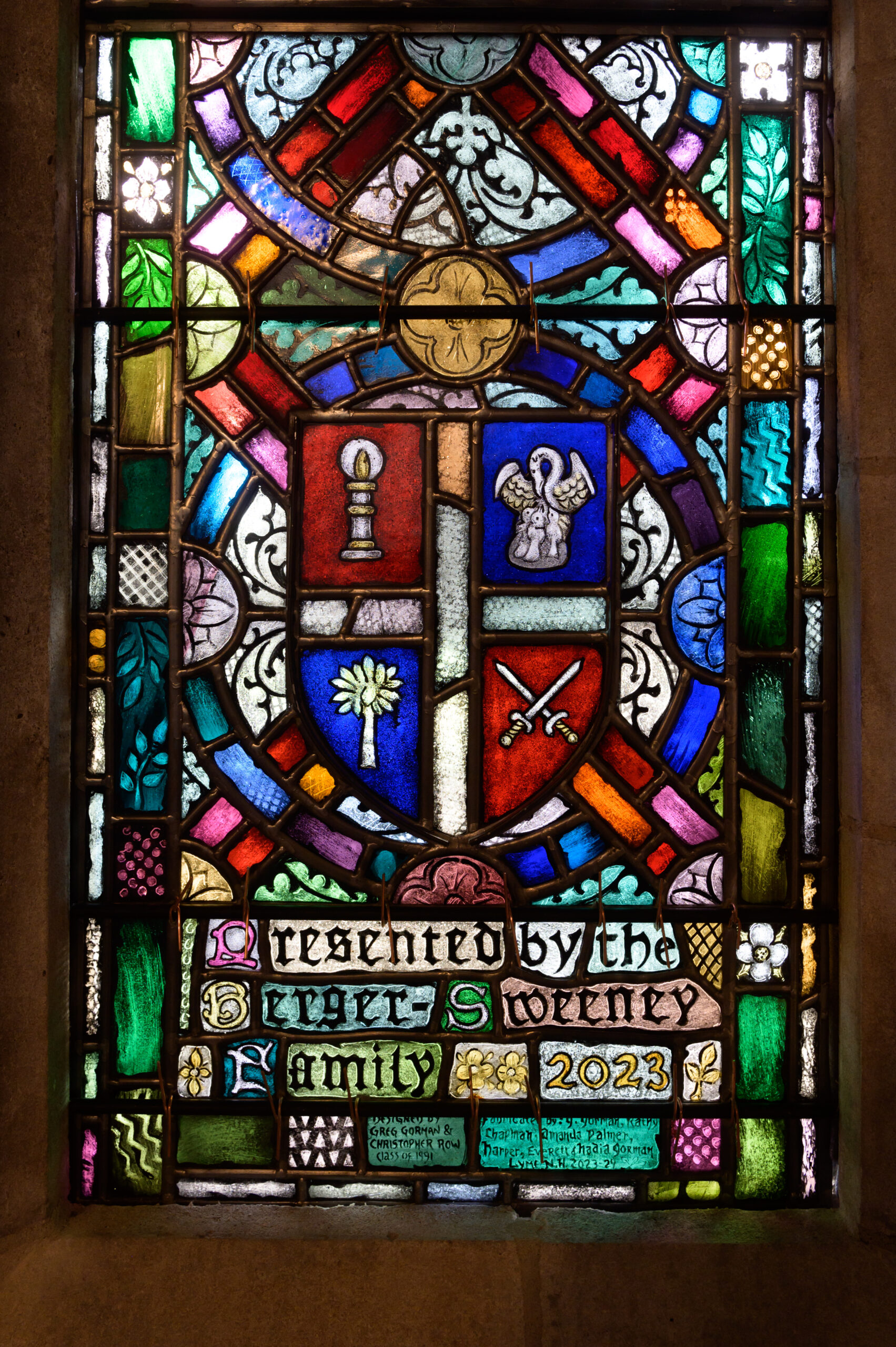
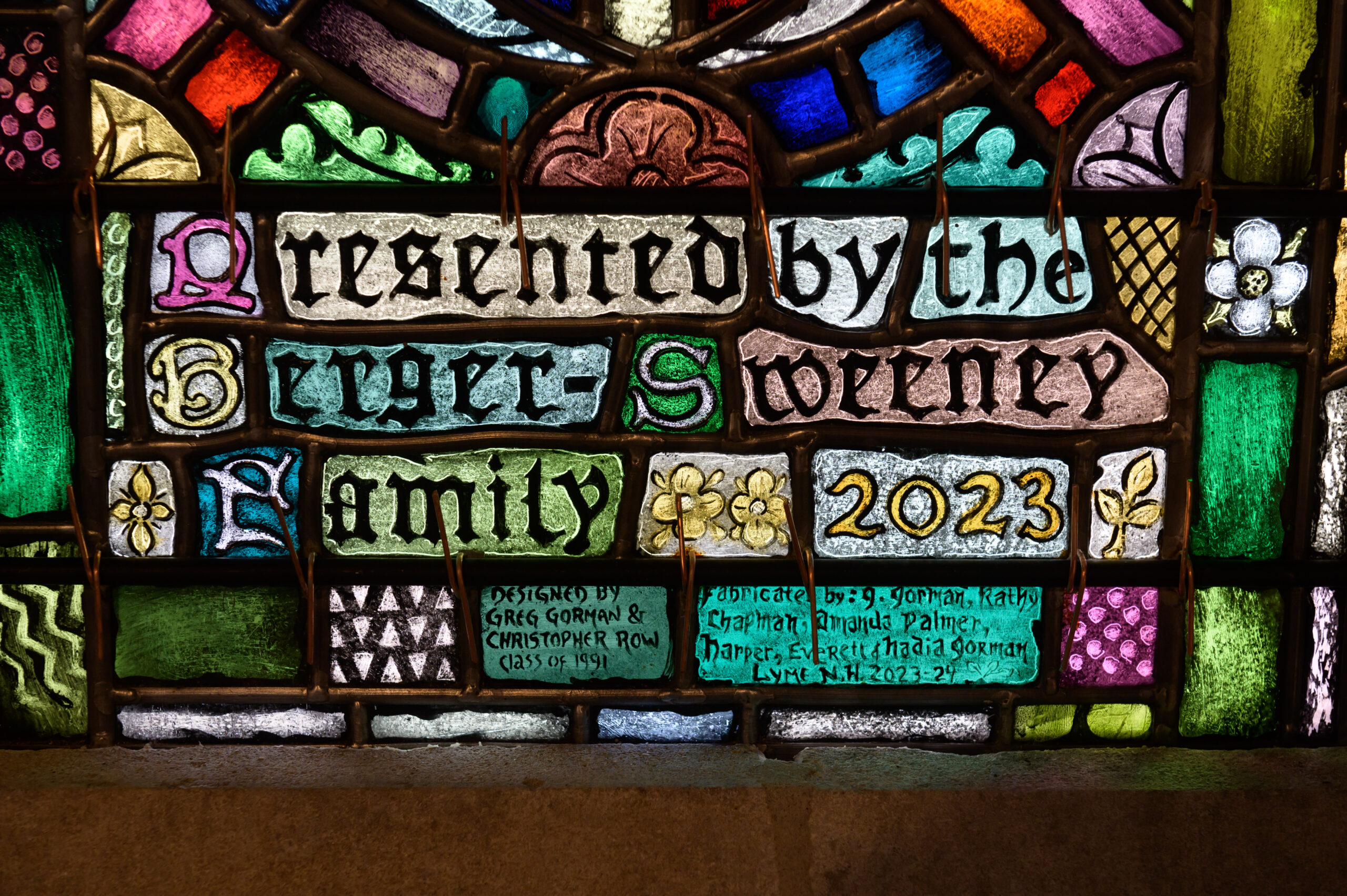
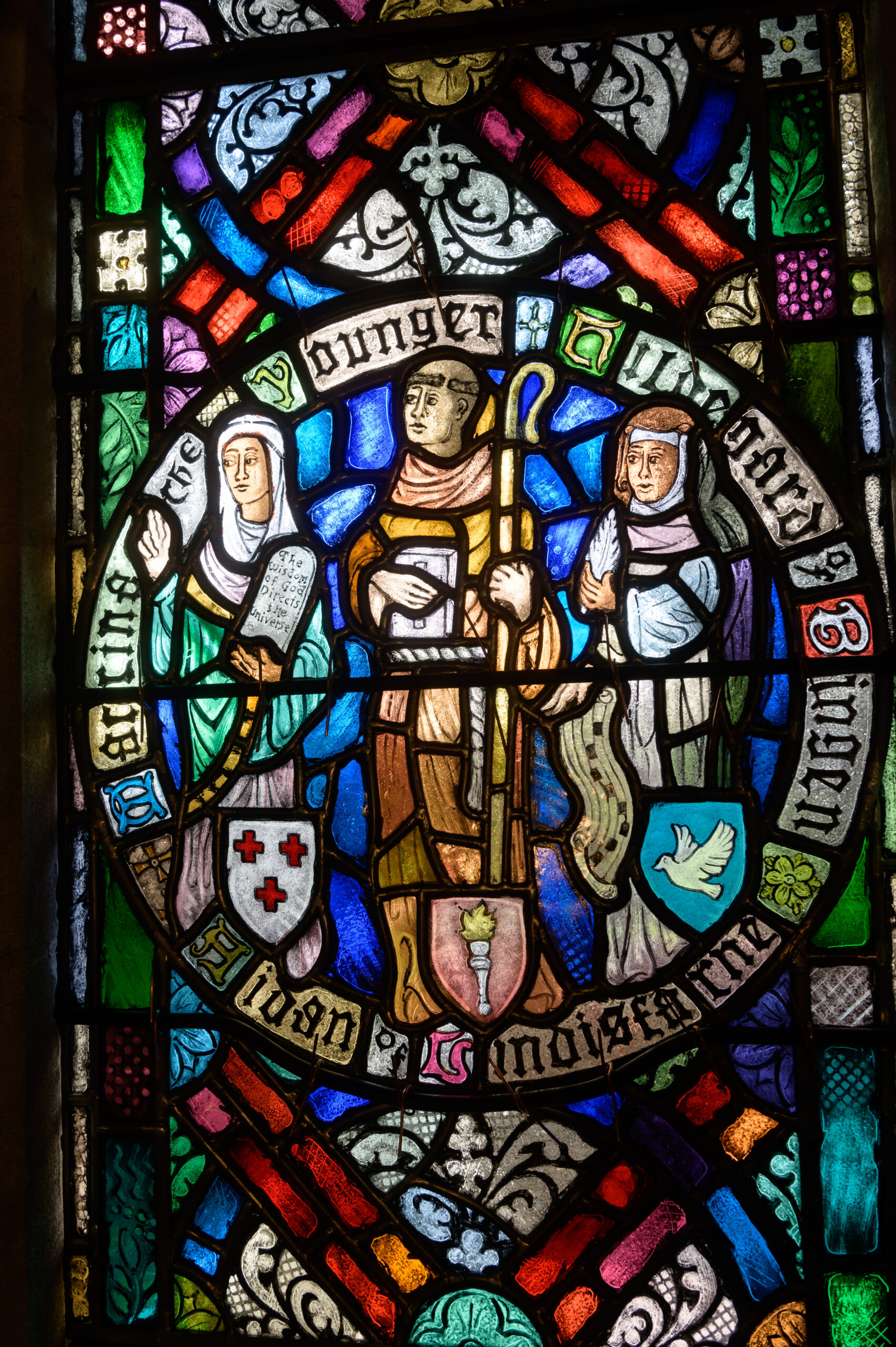
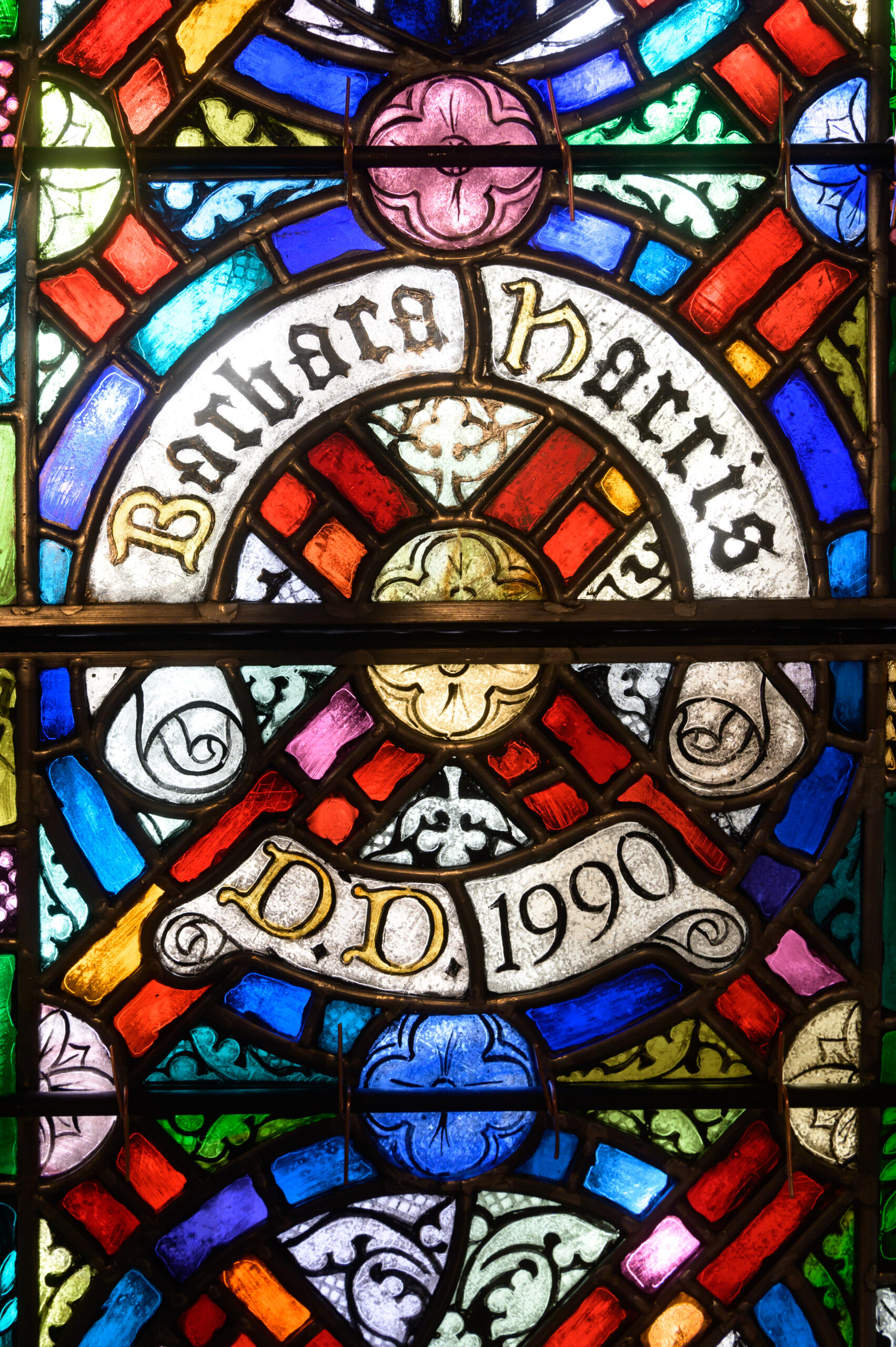
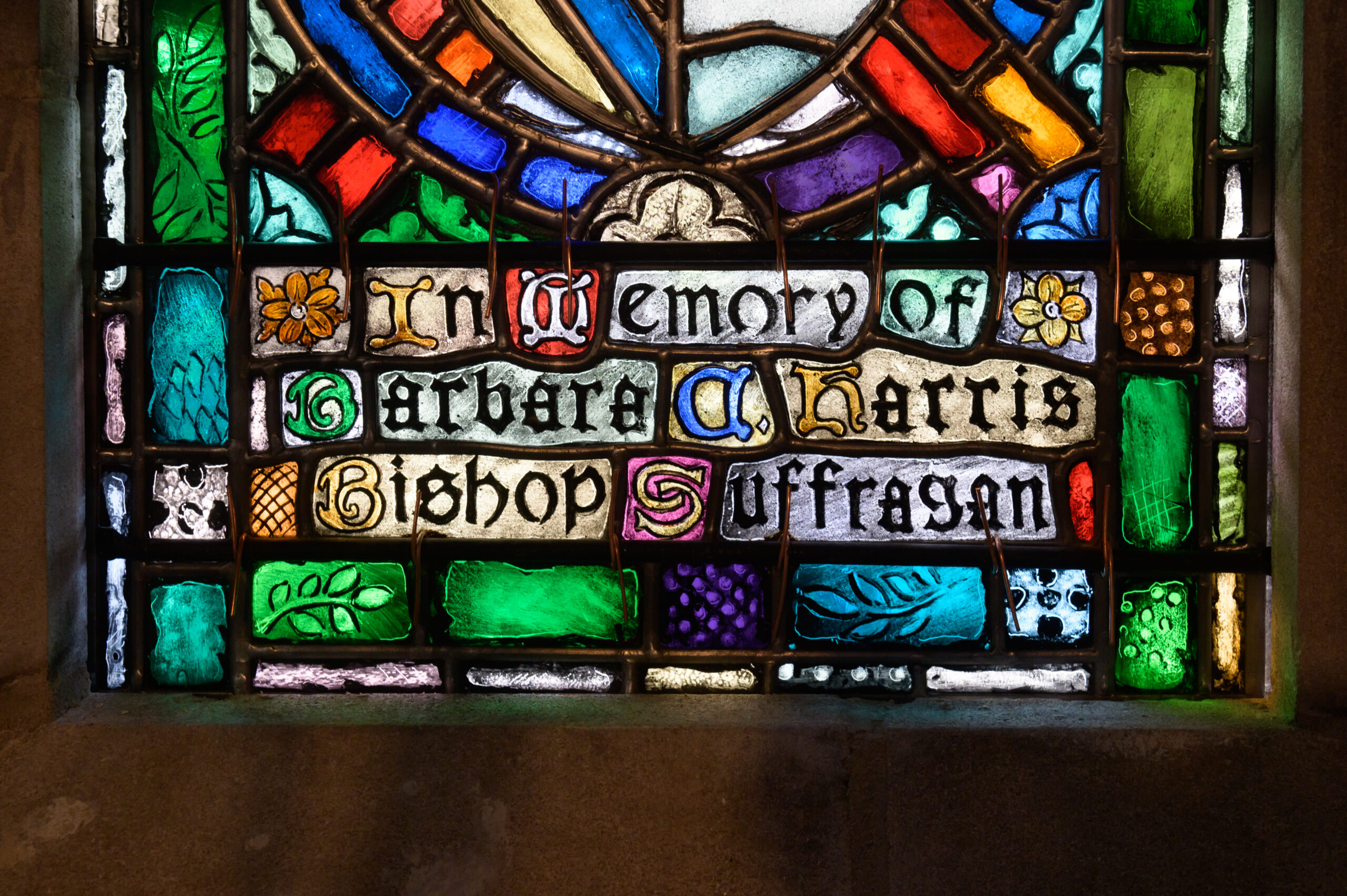
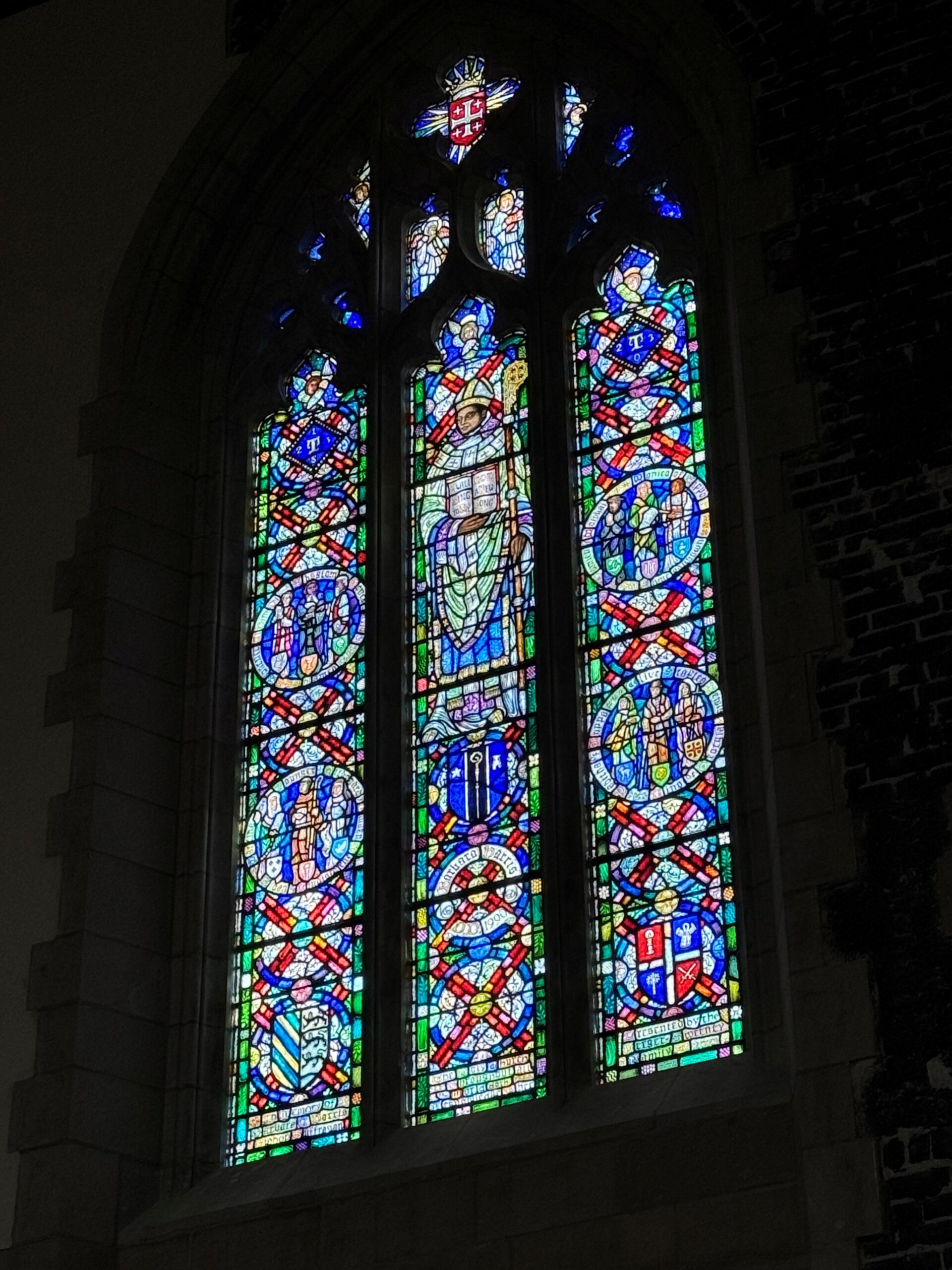
Photo courtesy of Christopher Row ’91.
